Catamarans: A Complete Guide to Multihull Boats
Catamarans have been a part of sailing history for centuries and continue to be popular for their stability, spaciousness, and performance. Developed by various cultures around the world, the principles of catamaran design have evolved over time to become optimized for both pleasure cruising and racing. This complete guide will help you understand the essentials of catamarans, their unique characteristics, and how to choose the right one for your needs.

From the basic concepts of multihull design, performance, and handling, we will explore the advantages and benefits of a catamaran in terms of safety and comfort on board.
Along the way, we will discuss maintenance considerations, distinctive catamaran brands and models, and how a catamaran lifestyle can compare to more traditional sailing options .
Finally, we will provide learning resources and frequently asked questions tailored to both seasoned sailors and newcomers to the world of catamarans.

Key Takeaways
- Catamarans are known for their stability, spaciousness, and performance
- This guide covers aspects like design, handling, safety, and choosing the right catamaran
- Resources and frequently asked questions provide additional insights for potential catamaran owners
Understanding Catamarans
Design Characteristics
Catamarans are known for their unique design, which features two parallel hulls connected by a deck. This design provides several advantages over traditional monohull boats, such as stability and speed.
With their wide beam, catamarans have a reduced risk of capsizing and can access shallow waters due to their shallow drafts 1 .
One of the notable aspects of a catamaran is its twin hulls, which offer increased living space and comfort compared to a monohull. Additionally, catamarans are often favored by recreational and competitive sailors for their excellent maneuverability 2 .
The materials used for constructing catamarans range from wood to fiberglass, and even aluminum for high-performance vessels. Aluminum catamarans are known for their strength, lightweight structure, and resistance to corrosion 3 .
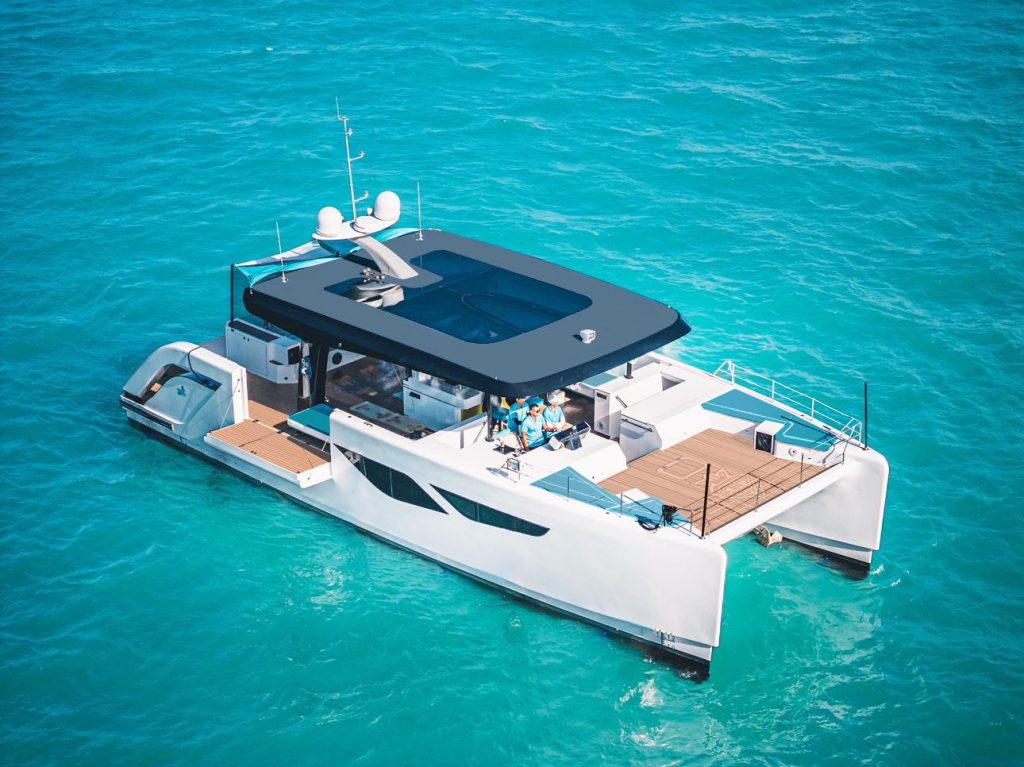
Hulls and Construction
The hulls in a catamaran are crucial to its stability and performance. These hulls help distribute the weight evenly across the water surface, minimizing drag and allowing for smoother sailing.
In general, the hulls can be categorized into two types:
- Symmetrical Hulls : The hull shape is similar on both sides, which enhances balance and stability in various sailing conditions.
- Asymmetrical Hulls : One side of the hull is designed differently than the other, which can be advantageous when sailing upwind.
The construction materials used in building catamaran hulls also play a vital role in the boat's performance and durability. Common materials include:
- Fiberglass : A popular choice due to its lightweight, strength, and ease of maintenance.
- Wood : Traditional material that offers a classic look, but requires more maintenance than fiberglass or aluminum.
- Aluminum : Lightweight and strong, aluminum is an excellent choice for high-performance catamarans 4 .
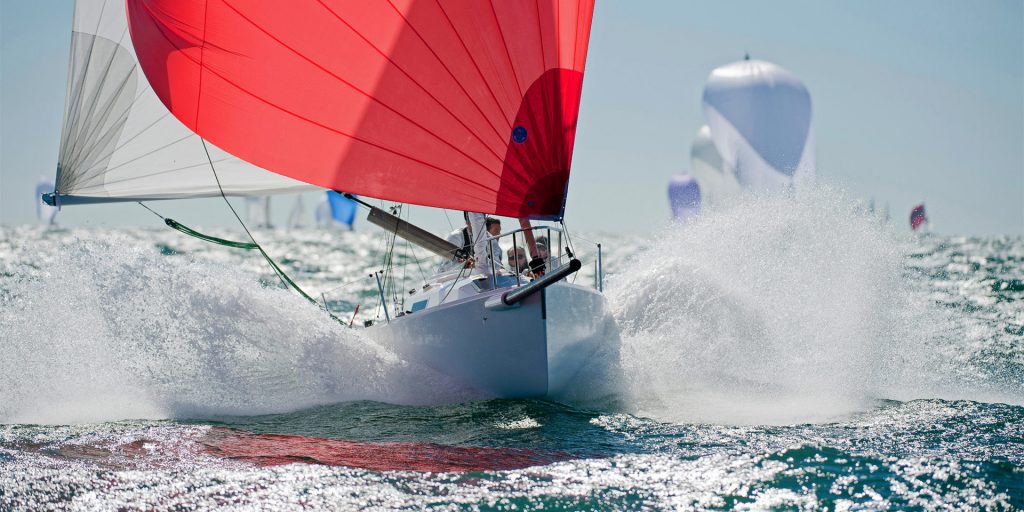
Multihulls vs Monohulls
There's often a debate between the benefits of multihull boats, such as catamarans or trimarans, and monohull boats. Here are some key differences between the two:
- Stability : Due to their wide beam and reduced heeling, catamarans offer improved stability compared to monohulls. This makes them an attractive option for those who want to avoid seasickness or feel more comfortable on the water 5 .
- Speed : Multihull boats are known for their speed, which results from their ability to minimize drag and maintain a level sail.
- Living Space : Catamarans and other multihulls generally have more living space, as both the hulls and the connecting deck can be utilized for accommodation and storage.
- Maneuverability : While monohulls are known for their agility and ability to point close to the wind, catamarans can still offer exceptional maneuverability when properly sailed 6 .
Performance and Handling
Speed and Efficiency
Power catamarans have gained popularity for offering a unique combination of speed, efficiency, and stability. Their dual-hull design allows for less water resistance, which directly translates to higher speeds and better fuel efficiency compared to traditional monohull boats.
In addition, the wide beam provided by the two hulls ensures a stable ride even at higher speeds. This makes power catamarans ideal for cruising, fishing, and watersports ( Boating Beast ).
Sailing Dynamics
When it comes to sailing catamarans , the performance is affected by factors such as keel, rudders, mast, and sails.
Their wide beam and dual-hull design provide inherent stability and reduced heeling effect, making them less likely to capsize compared to monohulls.
I should also note that catamarans have a shallow draft, which gives them the ability to access shallow waters that may be off-limits to other boats ( Navigating the Waters ).
In my experience, the lighter weight of a catamaran and its aerodynamic design can contribute to remarkable sailing performance under different wind conditions.
The larger sail area relative to hull weight allows them to harness more wind power, further enhancing their speed and agility on the water.
Maneuvering and Docking
Maneuvering and docking a power catamaran involves understanding its unique handling characteristics.
The presence of two engines in separate hulls allows for more precise control in confined spaces such as marinas.
The maneuverability of these boats is typically improved by the use of dual rudders that are located close to each powered hull for efficient steering ( BoatUS ).
When docking under power, I find it helpful to carefully assess the wind and current conditions beforehand.
This is because catamarans can be more sensitive to windage due to their larger surface area above the waterline.
By understanding how these forces may affect the boat, I can make adjustments to my approach and successfully dock the catamaran without any incidents.
Safety and Comfort on Board
Safety Features
Safety is a top priority when sailing any type of vessel, including catamarans. A well-built catamaran offers several features aimed at ensuring the safety of those onboard.
First, catamarans have inherent stability due to their wide beam and twin hull design . This makes them less prone to capsizing than monohull boats. This stability allows me to confidently navigate various water conditions .
In addition to stability, catamarans are designed with positive buoyancy, making them almost unsinkable . Of course, safety equipment such as lifejackets, flares, and first aid kits should always be onboard and well-maintained.
Furthermore, you should also stay updated on weather conditions, avoid sailing in high-risk areas, and learn your boat's safe sail limits.
Living Spaces and Comfort
When it comes to living spaces, I value comfort and practicality as essential features for my time on the water. Catamarans offer a unique advantage in this regard, as their dual hulls create spacious living areas.
Most catamarans are designed with separate cabins in each hull, allowing for privacy and comfort when sleeping. Additionally, these boats typically feature shallow drafts , which means I can access shallow waters and anchor close to shore.
The main living area, or salon, is situated on the bridge deck between the hulls. It usually includes a seating area, a dining table, and a galley (kitchen). Large windows provide ample natural light and panoramic views, making the space feel open and bright. Some catamarans even have the option for an additional living area on the upper deck where you can enjoy the sun and breeze.
One aspect of catamaran living I truly appreciate is the ample storage available. Each cabin typically has built-in storage spaces for clothes, gear, and personal items. There are also designated areas for equipment such as spare sails, tools, and water toys. This makes it easy for me to keep my belongings organized and make the most of my time on the water.
Maintaining a Catamaran
Routine Maintenance
In order to keep my catamaran in the best possible shape, I make sure to perform routine maintenance tasks. These tasks are essential to extend the life of the components and ensure smooth sailing:
- Cleaning : Regularly cleaning the deck, hulls, and sails prevents buildup of dirt, algae, and other debris that could affect performance.
- Inspection : Periodically inspecting my catamaran allows me to detect any potential issues before they become significant problems. I pay close attention to the rigging, sails, and lines on my boat.
- Lubrication : Keeping all moving parts lubricated is vital to prevent friction and wear on components such as winches and pulleys.
- Antifouling : Applying antifouling paint to the hulls of my catamaran helps prevent the growth of marine organisms that can damage the boat and reduce its speed. Make sure to do this at least once a year.
Dealing with Wear and Tear
Despite my best efforts to keep my catamaran well-maintained, wear and tear is inevitable. Here's how I deal with common issues that could arise from regular use:
- Repairs : When I notice signs of wear on sails, lines, or rigging components, I make it a priority to repair or replace them promptly. Neglecting these issues can lead to more significant problems and affect the boat's performance.
- Hull maintenance : If I find dents, scratches, or stiff rudders on my catamaran's hulls, I address them immediately. Repairing any damage not only ensures smooth sailing but also prevents further issues from developing.
- Sail care : Over time, my sails can become stretched, torn, or damaged due to exposure to sun, wind, and saltwater. Regularly inspecting them for signs of wear and making any necessary repairs or replacements helps maintain optimal performance.
- Rust and corrosion prevention : Since my catamaran is made of various metal components, I need to protect them from rust and corrosion. I routinely check for signs of corrosion and apply anti-corrosive treatments when needed.
Catamaran Brands and Models
High-Performance Models
In recent years, there has been a growing interest in high-performance catamarans. I have seen a variety of brands and models that have impressed me with their performance capabilities. One notable brand is Fountaine Pajot , which has a long history of producing a range of sailing catamarans and power catamarans. Some of their popular models include the Tanna 47 and the Bali 4.4 .
Another high-performance catamaran I've come across is the Leopard 40 . Known for their speed and exceptional handling in various conditions, the Leopard brand started with sailing catamarans and has since expanded to include power catamarans. Their models range from 40 to 53 feet long, offering both power and luxury for those looking for a thrilling experience on the water.
Cruising Catamarans
When it comes to cruising catamarans, the Lagoon brand is synonymous with luxury and comfort. With a range of sailing catamarans from 40 to 70 feet long, Lagoon offers spacious catamarans for extended bluewater cruising. Their 60- and 70-foot power catamarans are equally impressive, providing ample living space and smooth sailing experiences.
I've also found the Aquila 42 PC to be a remarkable cruising catamaran. With a focus on design and innovation, Aquila has produced catamarans perfect for exploring the open sea with friends and family. Their spacious, stable designs allow for a more enjoyable and serene journey, ensuring you arrive at your destination comfortably.
The Catamaran Lifestyle
Anchoring and Cruising
I find catamarans to be a fantastic choice for cruising and anchoring , which is a critical part of living the catamaran lifestyle . Catamarans have several advantages when it comes to anchoring and cruising, such as:
- Stability : Due to their wide beam and twin hulls, catamarans remain stable during anchoring, which reduces the risk of seasickness.
- Shallow draft : Thanks to their shallow draft , catamarans can anchor close to shore, enabling better access to protected coves and more beautiful beaches.
- Speed : Despite their large size for cruising vessels , catamarans are generally faster than monohulls. This is a result of their slim hulls and reduced water resistance.
When it comes to anchoring, catamarans can make use of their shallow draft to anchor in locations that other boats cannot. This allows for a greater range of cruising spots, which makes the overall experience much more enjoyable and unique.
Living on a Catamaran Full-time
For many catamaran enthusiasts, the dream of living full-time on a catamaran is entirely possible. While not without challenges, there are several factors that make living aboard a catamaran an enjoyable experience:
- Spacious living areas : Catamarans generally have more living area compared to monohulls, providing ample space for the whole crew.
- Privacy : The separate hulls allow for private cabins, ensuring that everyone on board has their space.
- Stability : As mentioned earlier, catamarans are stable vessels, making living on them more comfortable than monohulls.
Choosing Your Catamaran
Comparing Models and Features
When I start to look for the perfect catamaran, the first thing I focus on is comparing various models and features .
I determine the key factors that are essential for my needs, such as size, passenger comfort, and performance. By doing so, I can identify which catamaran models are most suitable for me.
For example, if I plan to sail with a large group, I would look for a catamaran that offers ample space both inside and out.
To help me with my comparisons, I usually create a table or list of the different models and their features:
| Model | Size | Comfort | Performance |
|---|---|---|---|
| A | 40ft | Spacious | High |
| B | 35ft | Average | Average |
| C | 45ft | Luxury | High |
This visual aid makes it easier for me to sort the options and prioritize my considerations, such as price, yacht type, and brand.
New vs. Second-Hand
Another critical aspect of choosing a catamaran is deciding between a new or second-hand boat.
Both options have their pros and cons, and ultimately it depends on my preferences and budget.
If I can afford a new catamaran, I get the advantage of the latest design , features, and technology. Plus, I typically receive better warranty coverage and support from the manufacturer.
However, new catamarans are more expensive and can have long wait times due to high demand.
On the other hand, purchasing a second-hand catamaran can save me a significant amount of money, and I might find a high-quality boat with low mileage or well-maintained by the previous owner.
However, this option carries more risks, as I need to be knowledgeable about potential maintenance issues and conduct a thorough inspection before purchase.
Learning Resources
Books and Manuals
When it comes to learning about catamarans, there are plenty of books and manuals available.
One of the highly recommended books is Multihull Voyaging by Thomas Firth Jones. This book provides a comprehensive understanding of multihulls, including catamarans, and is an essential guide for any beginner sailor.
Another great book to check out is Catamarans: The Complete Guide for Cruising Sailors by Gregor Tarjan.
With a foreword by Charles K. Chiodi, publisher of Multihulls Magazine, this book covers all aspects of cruising catamarans. It includes detailed information on design, construction, and maintenance, as well as tips and tricks for sailing a catamaran.
Here are a few more books that I find valuable:
- The Catamaran Book by Tim Bartlett, an excellent resource for both beginners and experienced sailors
- Catamaran Sailing: From Start to Finish by Phil Berman and Lenny Rudow, a comprehensive guide to both catamaran racing and cruising
Online Content and Photography
In addition to books, you can find plenty of online content and photography about catamarans.
Websites like Sailaway Blog and Boating Guide offer tips, techniques, and how-to articles for sailing catamarans.
Many of these sites also include stunning photography, showcasing these beautiful vessels in action.
For those who prefer Kindle or e-books, many of these resources are available in digital format.
This makes it easier for you to access them anytime, anywhere, allowing you to keep learning and improving your catamaran sailing skills.
To further enhance your knowledge, you can also join online forums and communities dedicated to catamarans.
These platforms provide invaluable advice and first-hand experiences shared by fellow sailors, as well as recommendations for additional learning resources.
Frequently Asked Questions
What factors should be considered when choosing a catamaran for full-time living?
When choosing a catamaran for full-time living, consider its space and layout , as it will become your home.
Look for a design with a comfortable living area , ample storage, and sufficient berths for the number of people living aboard.
Also, consider fuel efficiency , ease of maintenance, and the catamaran's cruising range .
Lastly, the overall cost of ownership , including insurance and mooring fees, should be considered.
How do catamarans perform in rough sea conditions?
In general, catamarans are known for their stability, which is primarily due to their wide beams. This makes them less prone to capsizing when compared to monohulls.
However, their performance in rough sea conditions will depend on the specific model and design of the catamaran. Some may perform better in certain conditions than others, so researching and selecting the right design is essential.
What are the key differences between sailing a catamaran and a monohull?
One of the main differences between catamarans and monohulls is stability.
Catamarans have a wider beam , which makes them more stable and minimizes the risk of capsizing.
They also have shallower drafts, which allow them to access more shallow waters compared to monohulls.
Additionally, catamarans often have larger living spaces, making them more comfortable and suitable for cruising and full-time living.
What are the advantages of catamarans for long-distance cruising?
Catamarans offer several advantages for long-distance cruising.
Their wide, stable design provides a comfortable ride and reduces the risk of seasickness.
They can also attain higher speeds due to their reduced drag and generally sail faster than monohulls on certain points of sail.
The shallow draft allows them to explore more coastal areas and anchor closer to shore. Lastly, their spacious interiors make them ideal for extended cruises and living aboard.
How does one assess the value of a used catamaran on the market?
Assessing the value of a used catamaran requires thorough research and inspection.
Start by comparing the age, model, and condition of the catamaran to similar listings on the market.
Take note of any upgrades or additions made to the boat, as these can affect the price.
It's essential to inspect the boat in person or hire a professional surveyor to ensure there are no hidden issues that could affect its value.
What essential features should be looked for in a catamaran intended for ocean voyages?
For ocean voyages, look for a catamaran with a strong, well-built hull designed to handle rough conditions.
Safety features such as liferafts, adequate flotation, and sturdy deck hardware are crucial.
A reliable engine and well-maintained rigging and sails are also essential.
In terms of living space, opt for a catamaran with a comfortable, spacious interior and ample storage.
Last but not least, good navigation and communication systems are necessary for long-distance ocean voyages.
Related Articles
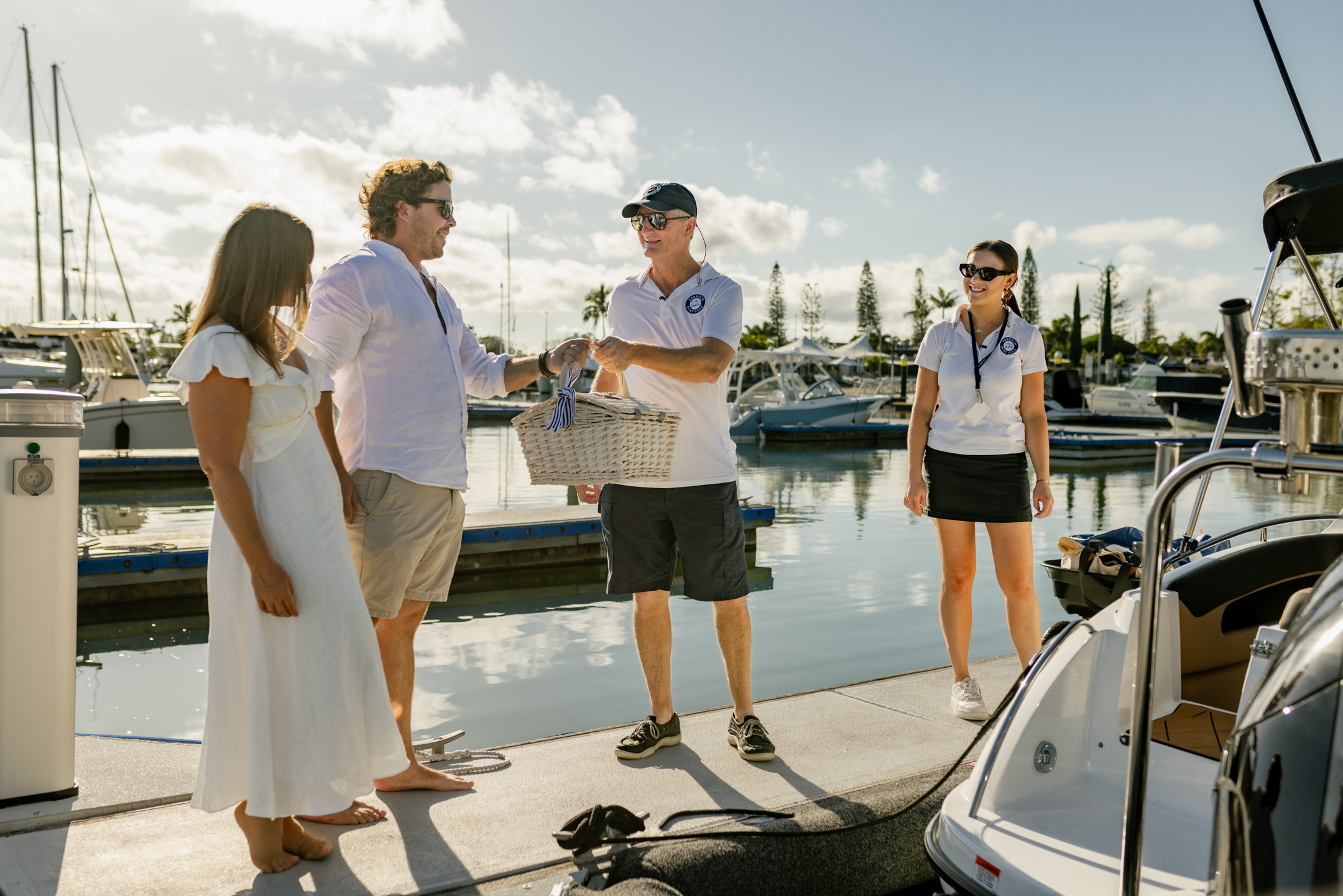
How Much is Freedom Boat Club: An Insider's Cost Breakdown

Googo Paddleboard: A Comprehensive Guide for Beginners and Enthusiasts
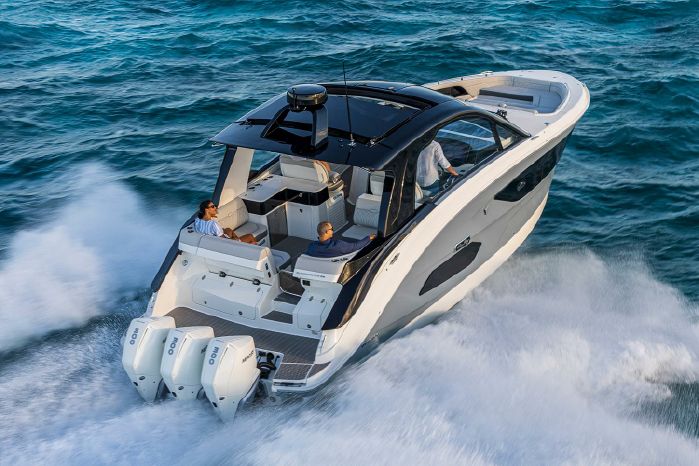
Sea Ray Sundancer: Ultimate Boating Guide for Enthusiasts

Setting Hook Broughtons
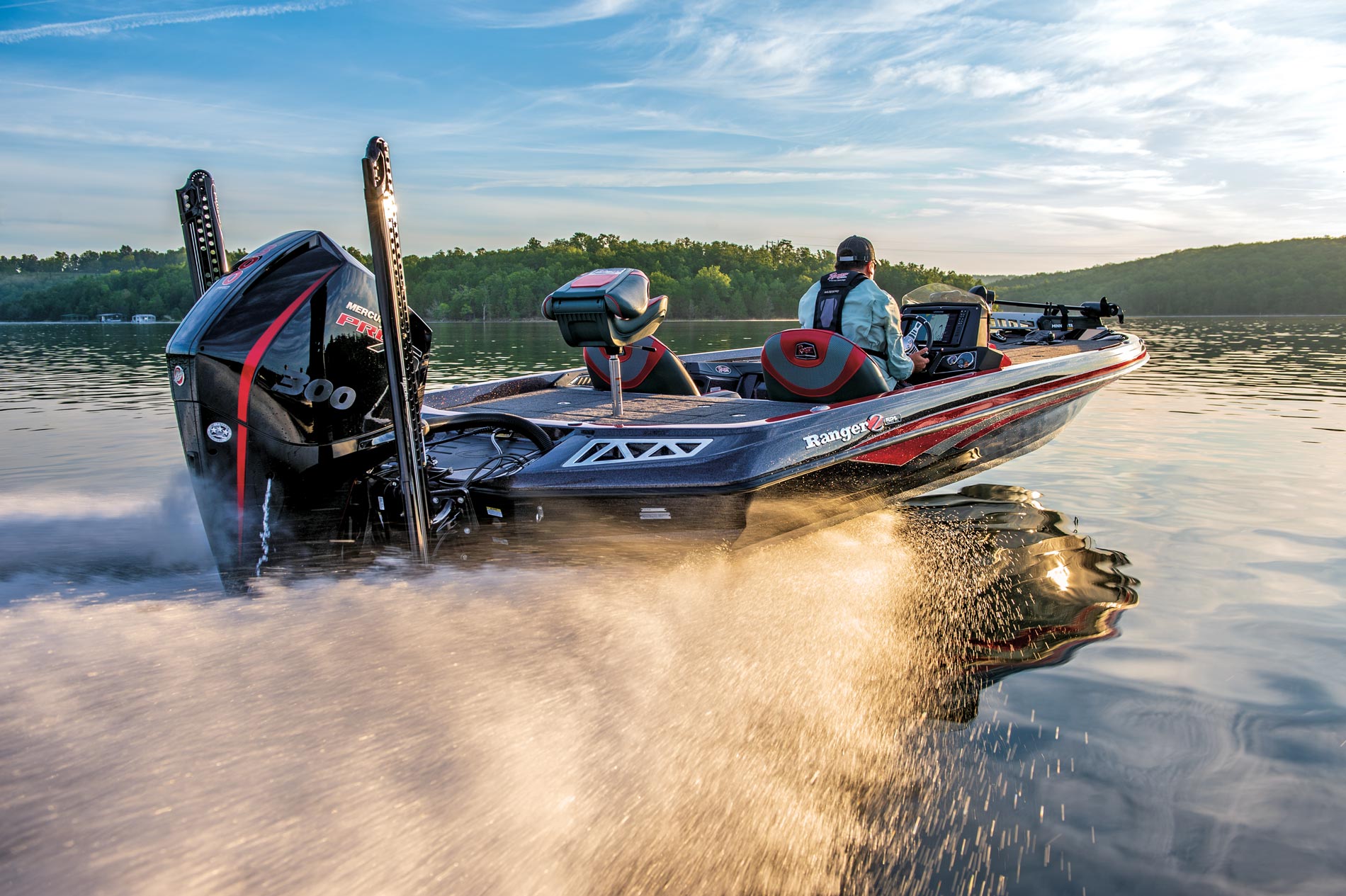
Top 10 Bass Boats for Sale Houston Texas: Premier Options for Every Angler
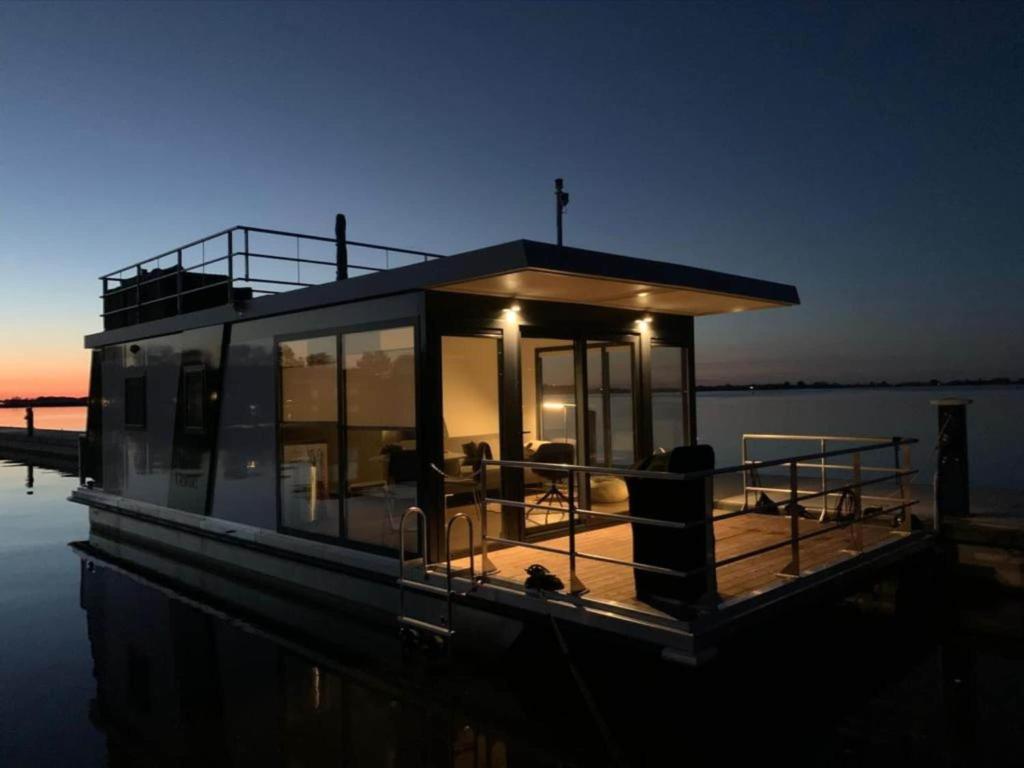
Houseboat Living: The Ultimate Guide
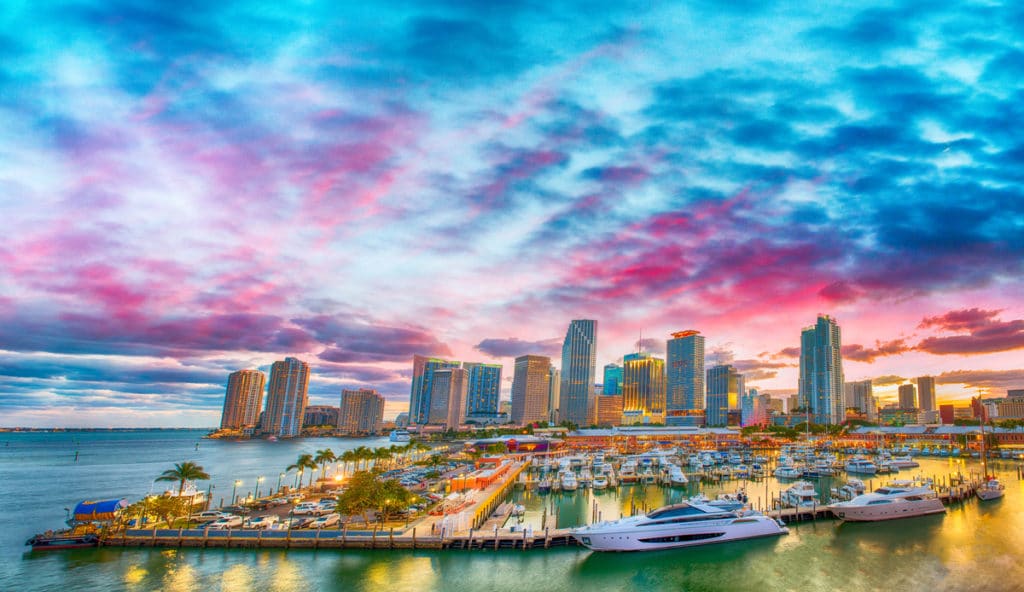
Marinas Near Me: A Comprehensive Guide to Nearby Boating Facilities
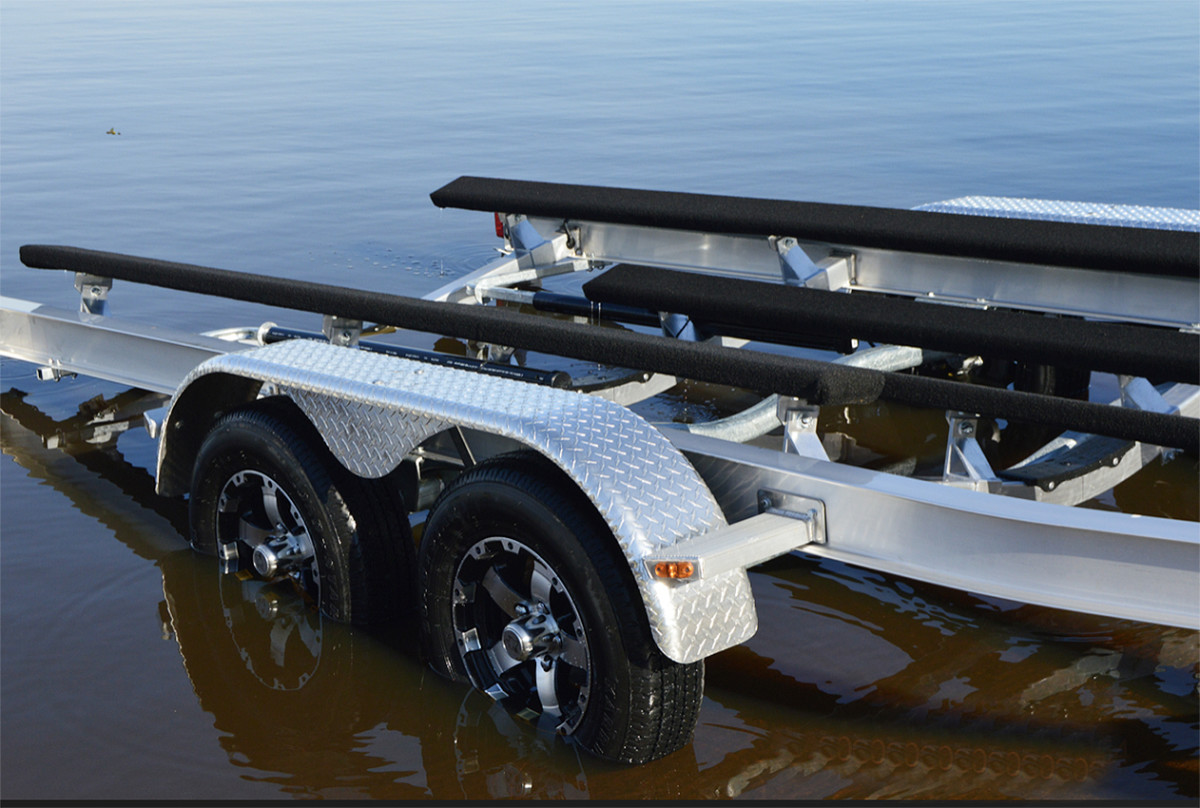
Boat Trailers for Sale: Top Picks and Buying Guide 2024

A Complete Catamaran Guide
- Post Written By: Boater Jer
- Published: January 26, 2020
- Updated: November 27, 2020

Disclaimer: You might notice that we recommend products in some articles. We may earn a commission for referring you if you click the link and buy a product.
We only recommend products we’ve tried/tested/own (that’s why you won’t find thousands of affiliate links on my site). If you have experience with one of the products we’ve mentioned, please share your experiences in the comments at the end.
There you are, out on the water when a strange craft approaches. Is it a sailboat? It sure looks like one until it turns to face you. That’s when you notice this boat doesn’t have just one hull. It has two hulls and it’s called a catamaran.
Catamarans are unique, and highly stable watercraft. We’ll explore all the ins and outs of sailing the waters in one of these weird, and awesome multi-hulled craft. Join me as we explore the wild world of sailing catamarans.
A History Of The Catamaran
It is believed that the first people to use a catamaran design were those living in Australasia.
The succession of boat design in this region was actually very interesting. The beginning of boats in the area was simple, albeit conventional rafts. These were fashioned from logs strewn together with plant fiber lashings such as those formed using bamboo fiber.
Catamaran Evolution
The conventional raft gave way to a minimal raft. This design was basically a conventional raft with two cross beams added in the form of logs. These would be eventually hollowed out to improve buoyancy.
The next step in the evolution of boats in the Australasian region was the double canoe. This proved to be the first real catamarans.
After some time, the form evolved further into the asymmetrical double canoe design. In this design, one canoe was large and the other attached canoe was smaller.
The asymmetrical design quickly evolved into the single-outrigger boat like the one shown in the photo below.
The final stage of the evolution of the catamaran in the region was to gain a second outrigger. This in effect created the trimaran with the single central hull and dual outriggers.
Eye Witness Accounts Of Catamarans
In 1697, William Dampier wrote of witnessing a type of seafaring vessel off the coast of Coromandel. He noted how the locals called the type of boat a catamaran. He also noted that it had multiple hulls (logs) and that they were small vessels that the person operating would have to hang partway into the water, straddling the hull (log).
The name catamaran came from the Tamil. And yet, it was easily applied by the European visitors to the two hulled sailing vessels that sped across the water in the region.
Although Dampier may have described the catamaran in the 1690s, the type of boat was actually used as early as the 5th century by the Tamil Chola dynasty. They used boats to move their troops from one island to another. Using this design of boat allowed them to travel heavy, travel quickly and was partially responsible for the conquering of neighboring Burma, Malaysia, and Indonesia.
Building A Boat – Basics Of Catamaran Construction
A boat is usually thought of as being a single-hulled vessel that travels along the surface of the water. It can have multiple types, shapes, and designs of the hull. However, it is often only thought of as having a single hull. But, what if it had two hulls? Would that be like taking two separate boats, and making a raft over both of them? In essence, that is exactly what a catamaran is: two boats made into one.
Advantages Of Multiple Hulls
- More stability than a monohull
- Wide supporting base allows for larger sails than monohull craft of the same length
- Hull does not require the deep-running keel of a standard monohull sailboat
- Less hull drag in the water than a monohull
- Less power required to drive a catamaran forward than a monohull boat
Disadvantages Of Multiple Hulls
- Due to multiple hulls, construction is more expensive than a monohull design
- Catamaran speed relies on lightweight materials to make a lightweight craft. This also drives up the cost of construction.
- Extra engineering requirements for multi-hull craft also increase the cost of construction.
Conclusion? Well, it looks to me like everything about catamarans points towards superiority over monohulls in nearly every way. But, you get what you pay for. I think the same thing likely applies to cars too. For instance, I have a performance car that cost me about 10k more than the equivalent non-sports car within the same class.
Yet to drive the vehicle, it performs so much better than the normal version of the car, it really speaks volumes to the difference between a common vehicle, and a performance one.
Speaking of performance vehicles, let’s take a look now at the different kinds and uses of a catamaran.
Catamaran Types
Commercial catamarans – ferries.
One of the most common uses for a catamaran is the commercial use of the vehicle design when it comes to ferries. This is likely due to the wide, flat deck possibilities of a catamaran versus a monohulled boat. Not only that, but the catamaran is also a much more stable bodied vessel. This again makes it a superior design for transporting larger land vessels like trucks and so forth. They can easily drive on the ferry without fear of the ferry tipping over.
Some ferries are designed for taking vehicles, like the one you might find in the city of Toronto. Where it transports cars from the mainland to Toronto Island. Others are designed specifically with the sole purpose of transporting people. I took a look at one such ferry that operates in Germany. Take a look at the following case study.
Commercial Use Case Study – The Ferry
The FRS Helgoline is a ferry catamaran operating out of Flensburg, Germany, close to the Danish border.
According to the ferry company’s website, the ferry runs using four main engines which are run to a capacity of 12,182 hp combined. This blasts this ferry at a speed of 35 knots or 65 km/hour. This is equivalent to 40 miles per hour. That’s pretty good considering the size and weight of the ship body this catamaran can carry.
Speaking of capacity, the ship can carry 680 passengers. At 56.4 meters long (185 feet) by 14 meters wide (45.9 feet), that’s a decent passenger capacity.
Catamaran Passenger Capacity Versus Monohull Boat Passenger Capacity
The general rule for calculating passenger capacity for a boat is as follows.
Length x Width / 15 = Passenger Capacity
Therefore, the FRS Helgoline should have a calculated capacity calculated as follows.
185 x 45.9 / 15 = 566
But it actually has a capacity of 680 which is a 20% increase in capacity over a standard monohull.
For comparison, let’s look at a superyacht. A 48.5m (159 feet) long by 10.7m (35 feet) beam (width of the boat) Palmer Johnson Supersport 48 (valued at about $28.5 million dollars) should have a capacity calculated as follows.
159 x 35 / 15 = 371
In short, 26 feet of difference in length equates to 309 fewer passengers. It is almost half of the capacity of the catamaran at 26 feet longer length.
Photo courtesy of https://sysyachtsales.com/
Commercial Catamarans – Service Vehicles
Although Catamarans are typically used as ferries due to their stability and ability to carry wide loads on their flat decks, there are many different service catamarans out there as well. From a support vessel to a crew transfer or search and rescue, catamarans are a solid and stable platform to build a ship on.
This is the Ardea which is a 20 meter (65.6 feet) catamaran to be used for crew transport and as a support ship. This ship was built by the Echo Marine Group and delivered to Western Australia in early 2019. This particular vessel is in the service of the Cape Preston Sino Iron Project.
Catamarans are used all around the world, for a variety of tasks, not just ferries or support craft.
Commercial Catamarans – Cruise Lines
Now these are the catamarans we all want to be aboard, aren’t they? Due to the wide stance, these ships can feature massive halls and wide-open interior areas. These ships are stable, and some would say even more stable and safer than monohull design ships.
There are many cruise ship catamarans in use today around the world. Some of the more ‘famous’ catamaran cruises are those which investigate the Galapagos Islands. There are several high-end, small fleet, cruise lines operating to the Galapagos which utilize catamaran design vessels as their primary ship type.
These ships can be extremely comfortable and stable and often offer some reprieve to those who may otherwise feel seasick. It won’t stop the feeling, but the more stable the hull, the less the boat rocks around.
Military Catamarans
Catamarans make excellent military transport vessels. They are stable and the potential to have a large, flat and wide deck for transporting land craft, troops or acting as a landing pad for vertical take-off aerial craft. The stability of the two hulls makes the vessel an excellent candidate for military use, and thus it is used for said purpose.
As you can clearly see in the image of the USNS Spearhead, the rear of the vessel has a moveable ramp that can be used for loading and unloading land vehicles. The interior bay of the craft is visible in the image as well, a large area for storage of vehicles, supplies and more. The crane arm on the back of the ship also shows how it is a versatile craft, set up to act as an excellent support craft with a helicopter landing pad and ample storage and freight capacity.
Recreational Catamarans
Catamaran Personal WatercraftThe wind is in your hair, the warm spray from the hull cutting over the edge of each wave as you skip over the water. That is life, let me tell you. Personal watercraft have come a long way over the years and the small one, two, three and four-person catamarans have come a long way as well.
Depending on the options, you can get a small one or two-person catamaran for as little as $1500 new. That might be an inflatable though. There are some very nice, rigid hull designed catamarans for 1-4 people that range from $3500 to $15000. And these are basically open, personal watercraft like that shown in the image below.
Using a small catamaran can be quite challenging to learn at first. Sailing is not for the faint of heart. It requires skill, technique, knowledge of the wind and sea, and a bit of hard work. But it can be fun, rewarding and a great way to catch some sun and fresh air out on the water. It’s a relatively GREEN sport as well. Given the use of sails over gas-powered motors that is.
‘Sailing Cats’ – Sailing Catamarans – Yacht & Luxury Class
Here’s where we get into the dreamy boats of the rich and famous. I priced out a small 43’ luxury Leopard 40 sailing catamaran. Even before I added any extras at all, the base price was $399,000 USD. I imagine if I added a few of the multiple extras available, and some tax, freight and that sort of thing, I’m easily in half a million dollars. And that’s the smallest base model.
There are all kinds of luxury catamaran shipbuilders across the world. From Asia to Europe and The Americas, it seems any major boating country has at least one company building luxury catamarans. It’s weird that you don’t see more of them on the water though, don’t you think?
Being sailing vessels, these luxury cats require some training in sailing before you get behind the wheel. And considering the price point, I would definitely want to be at least a semi-decent sailor with some good few years experience under my belt before I would comfortable at the helm of a half-million-dollar sailing cat. It’s all relative I suppose. I imagine a billionaire might bat an eye at the prospect of wrecking a half-million-dollar boat. But to me, and most of you reading this, that’s likely a lot of money.
‘Power Cats’ – Powered Catamarans
The powered catamaran is one of my favorite boats. They have sort of a muscle car appearance with the wide and often tall front end of the boats. I find it to be reminiscent of a large air intake on the front hood of a rally race car like the Subaru WRX, for instance. These boats are fast, they are stable and handle very well. Catamarans are often considered the boat of choice for long sea voyages due to their stability.
A powered catamaran will definitely cost more than a powered monohull boat of the same length. Why? Well, the powered catamaran has one crucial downside. That is, it needs two engines. One for each of the two hulls. Otherwise, it’s off balance for propulsion. These two engines or motors have to be in sync with each other or again, the propulsion will be off-balance. Because they have two motors, they have double the maintenance when it comes to maintaining the propulsion system.
More components also means a greater chance of things breaking down. In essence, it doubles the chances of the ship having a motor break down. The saving grace is that should one motor break, they have a backup, even if it does mean very unbalanced propulsion. In contrast, a monohull vessel of the same length may only have half the chance of motor failure due to only having one motor, but if that one motor breaks, then what? Call for help, that’s what. A cat would have a struggling chance to get itself back to port. A monohull would be dead in the water unless it was carrying spare parts or another motor onboard somewhere.
Catamaran Frequently Asked Questions
What is a catamaran cruise.
A catamaran cruise is simply a cruise on a dual hull design boat. Often used for river cruises, the catamaran which is used as cruise ships are often considerably smaller than their giant monohulled counterparts.
What is the purpose of a catamaran?
A catamaran is a design for a boat that utilizes two hulls. Due to the flat, platform-like-potential for the deck of the boat, the catamaran is often purposed with transporting materials, vehicles, and people. For instance, catamarans are quite often used as ferries.
Is catamaran safe?
Catamaran are very safe water craft. The design of riding on two hulls separated by a gap in between, in essence is like giving a car a double-wide wheel base. The wider the stance, the more stable the craft, from side to side anyway. And if the length of the boat is proportional to the width, then it becomes an extremely stable craft. That is why catamarans are often considered the best to be used for long voyages. Yes, catamaran are safe.
What is the difference between a catamaran and a sailboat?
A traditional sailboat is a deep, monohull vessel that has at least one mast extending high into the air above the deck to hold sails. A catamaran refers to the design of a dual-hull boat and really has nothing to do with sails. Although, catamaran do make excellent sailing boats as well, they are quite capable of acting as power boats and do not require sails if they have the correct amount of powered motors to propel them. Sailboats, although also able to be powered if a motor is provided, are traditionally monohull and wind-powered exclusively.
Do catamarans have small interiors?
The size of an interior cabin on a boat is typically proportional to the size of the boat itself. If a catamaran has above-deck cabins, they will likely be able to be of a larger design than those you would find on deck of a monohull boat. This is because a catamaran has a much wider footprint than a monohull boat of the same length. This extra width would allow for larger on deck cabins.
How much does a catamaran cost?
A personal watercraft (1-2 person) inflatable catamaran will run you anywhere from $1500-$12000 USD, depending on the quality and features. The rigid hull catamarans of the same size start at about $4500 USD.
A small cabin cruiser type of catamaran will typically start at about $60000 for a small base model and the price just goes up and up depending on size and features.
For Instance, a 40’, 3 cabin with 1 washroom cat will cost you about $500,000 USD for the base model. They are considerably more expensive that a monohull of the same length. However, the trade-off is greater stability and a smoother, more comfortable ride.
Is a catamaran more work to maintain?
Technically yes. Due to having two hulls and if powered, two motors and likely also water jets, this means you have double the oil changes of a boat that would have a single motor. Once you get past the basic engine and hull maintenance, a catamaran is not that much more work than a monohull ship of the same length.
The trouble with catamarans in terms of maintenance, is that once they reach a certain length, the width becomes more than a standard lane on the road. That being said, if you ever need to transport the boat via land, it can be quite the challenge. Especially if you need to pay to have a police escort for an extra-wide trailer. And special licensing might be involved as well.
What is the difference between a catamaran and a trimaran?
A catamaran is a dual hull boat. In other words, it has two hulls. A trimaran has three hulls.
Is a catamaran considered a yacht?
According to Oxford dictionary, a yacht is a medium-sized sailboat equipped for cruising or racing. A catamaran, on the other hand, is a boat with two hulls. Therefore, a catamaran can most certainly also be a yacht. And likewise, if a yacht has two hulls, then it is a catamaran as well.
Can you get seasick on a catamaran?
Seasickness occurs when a person feels nauseous from the swaying motion of a rocking ship. These feelings may be lessened on a catamaran, due to their extra stability. However, a catamaran may be slightly more stable than a monohull of the same length, but it is still a boat. And it will still make someone who experiences seasickness continue to feel the ill effects.
Are catamarans more stable in rough seas?
Catamarans are known to be more stable than monohull ships of the same length. This is why catamarans are often the ship type of choice for long sea voyages due to their stability.
Why do catamarans capsize?
Catamarans are not known for capsizing. The larger vessels that is anyway. But, it does happen from time to time. Catamarans are known for their stability, so typically if a capsize event should occur, it is typical for them to be extreme circumstances.
Personal watercraft catamarans are a different story though. These are in fact known for tipping over. Not because they are less stable than their monohull counterparts of the same length. But instead, because they are able to go considerably faster than monohull personal watercraft of the same length (not including powered craft though). This is due to the sailing cats being able to have a larger sail than a small monohull sailboat of the same length.
Due to the extra sail, they are able to travel faster than monohull sailboats of the same length. This allows them to whip around on the water and at higher speeds, whipping your cat about quick can easily send it over sideways. Extra speed means fast turns carry momentum in the direction of travel and that extra speed equates to tipping over if turned too fast. To sum up, they capsize due to user error or extreme events.
Which is safer, a catamaran or a monohull?
Due to the extra stability of having a wider footprint than a monohull, a catamaran of the same length is the safer vessel.
Are catamarans safer than sailboats?
The same rule applies to stability versus the length of the hull. A cat will always be the more stable length for length. However, due to their ability to go much faster than a monohull sailboat, this kind of cancels out some of the added safety due to stability. With that in mind, they may just be about the same but there is one generalization we can make when comparing the safety of catamarans vs sailboats: At the same speed, and of equal length, sailing or power catamaran will be safer than a monohull sailboat.
How fast can catamarans go?
The speed a catamaran can go is entirely dependent upon the hull design, weight of the vessel, the strength of propulsion (be it wind or powered) and so on. The general rule is that in terms of sailing cats vs monohull sailboats, a cat of equal length can typically go faster than a sailboat.
In terms of powered cats vs powerboats, a powered catamaran will typically require less energy to move forward than a monohull of the same sort of hull design (but monohull of course) and thus a cat should, in theory, be able to go faster than a monohull when both are using propulsion that is equal in power.
Bibliography
- Wikipedia – Catamarans
- Mahdi, Waruno (1999). “The Dispersal of Austronesian boat forms in the Indian Ocean”. In Blench, Roger; Spriggs, Matthew (eds.). Archaeology and Language III: Artefacts languages, and texts . One World Archaeology. 34 . Routledge. pp. 144–179. ISBN 0415100542 .
- Wikipedia – Spearhead -class expeditionary fast transport
- https://www.tiki-toki.com/timeline/entry/169516/Origin-of-the-catamaran/#vars!panel=1620923!
- https://www.austal.com/ships/passenger-express-56
- https://www.adventure-life.com/galapagos/galapagos-catamaran-cruises
Boating Gear
Take a look at our Recommended page for a variety of items. Here are some of the things you can expect:
- GPS And Fish Trackers
- Hitch And Trailer Supplies
- Lifejackets And Specialty Clothing
- Boating Books And More!

More From Boating Guide Magazine
- Pontoon Boat Basics
- The Complete Runabout Boat & Trailer Towing Guide
- Winterizing Your Boat
- Boating Gear Requirements For Canada And USA Waters
- Aluminum vs. Fiberglass Bass Boats
- Better Boating At Night & How To Survive The Darkness
- Staying Safe On A Catamaran: 24 Essential Tips
- Can A Catamaran Capsize?
- 4 Common Types Of Propulsion For Boats
Return To Home * About Boating Guide * About The Author
fakewatches.is
Share this post with your friends.
- Tags: boat type , catamaran , catamaran basics , catamaran essentials , sailing
Subscribe to our Newsletter
Join us in our love for all things water. And Adventure.

The Geneinno T1 – A Professional Diving Drone With Robotic Arm
What’s so great about an underwater drone? Small drone aircraft systems are a ubiquitous sight these days. It is most unlikely that you haven’t spotted one in real life till now. But underwater drones are not something of an everyday view. Submarine ROVs or UAVs are making huge waves now (notice the pun?). No seriously!

This Is Why You Should Cover A Pontoon Boat
Covering a pontoon boat is a really smart idea. Here’s why. We also look at our favorite and cheap pontoon boat covers.
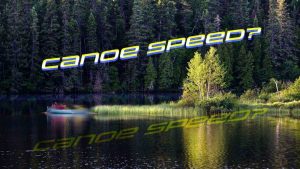
How Fast Can Canoes Go? We Find Out (With World Records).
Sliding over the glass-like stillness of a peaceful morning lake, a ride in the canoe is an incredible experience. The mist rising slowly off the water and wildlife waking to the coming day can be a nearly magical experience for the canoeist. However, it may not be only about peace and tranquility. If you like

This Is WHY Boats Back Into Slips
Wondering why boats back into slips? Well, wonder no more my friend, Captain Jer is on the case! By the end of this article, you’ll not only know why it’s a good practice to back your boat into a slip but also a lot more about boats, slips and a few handling tips too so ride along with me and dive into why boats back into slips.
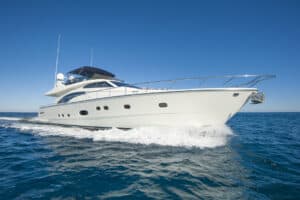
Catamaran Vs. Motor Yacht (4 Powerful Differences Explained)
The Catamaran Vs. motor yacht, a comparison that has lasted for ages, is one we will finally put to rest in this article. We promise to make spotting their differences easy. Differences Distinguishing the Catamaran Vs. Motor Yacht At the end of this section, everything that distinguishes these two sailing boats from each other will

When Boat Launches Go Horribly Wrong – A Tale Of Tragedy
I have never shared this story publically of the boat launch tragedy until now. If you are a boat owner or ever intend to be, you need to read this tragic story I’m about to share. It all began on a bright summer morning about twenty years ago. I was living in Brampton, Ontario, Canada,

Boat Information By Type
© 2023 Boating.Guide, A Hyperwave Media Group Ltd. Publication.
Privacy Overview
- 1.1 Etymology
- 1.2 Pronunciation
- 1.3.1 Synonyms
- 1.3.2 Hypernyms
- 1.3.3 Hyponyms
- 1.3.4 Coordinate terms
- 1.3.5 Derived terms
- 1.3.6 Related terms
- 1.3.7 Descendants
- 1.3.8 Translations
- 2.1 Etymology
- 2.2 Pronunciation
- 2.4 Further reading
- 3.1 Etymology
- 4.1 Etymology
- 4.2.1 Declension
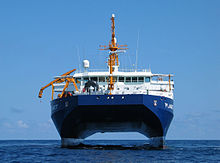
From Tamil கட்டுமரம் ( kaṭṭumaram ) , from கட்டு ( kaṭṭu , “ to tie ” ) + மரம் ( maram , “ tree, wood ” ) .
Pronunciation
- ( UK ) IPA ( key ) : /ˌkæ.tə.məˈɹæn/ , /ˈkæ.tə.məˌɹæn/
| Audio ( ): | ( ) |
- ( Canada , US ) IPA ( key ) : /ˈkæ.tə.məˌɹæn/ , /ˌkæ.tə.məˈɹæn/
catamaran ( plural catamarans )
- 1838 , [Letitia Elizabeth] Landon (indicated as editor), chapter XV, in Duty and Inclination: [ … ] , volume II, London: Henry Colburn , [ … ] , →OCLC , page 218 : Swift over the seas the vessel drives; Madras appears in sight. The first object catching the eye, upon the anchor being cast, was an Indian upon his catamaran , who, making a sudden motion, sprung to the side of the ship, grappled there for a moment, and the next was on the deck.
- 1889 , William Makepeace Thackeray, Hobson's Choice : She meddles with my prescriptions for your wife; she doctors the infant in private: you'll never have a quiet house or a quiet wife as long as that old Catamaran is here.
- 1808–10 , William Hickey , Memoirs of a Georgian Rake , Folio Society 1995, p. 90: Three or four strange-looking things now came close to our boat, which I understood were called ‘ catamarans ’, consisting of nothing more than two or three large trees, the trunk part only strongly lashed together, upon which sat two men nearly in a state of nature [ … ] .
- ( obsolete ) An old kind of fireship .
- ( twin-hulled ship or boat ) : twinhull , cat
- ( twin-hulled ship or boat ) : multihull
- ( twin-hulled ship or boat ) : AC45 , AC72
Coordinate terms
- outrigger canoe
Derived terms
- cat ( diminutive )
Related terms
Descendants.
- → Portuguese: catamarã
Translations
| / (shuāngtǐchuán) (katamarán), (dígastro) (katamaran) (sōdōsen), (katamaran) (ttenmok) , (katamarán) (kaṭṭumaram) (reua bai têe mee lam reua sŏng lam) (katamarán) |
From Tamil கட்டு ( kaṭṭu , “ to tie ” ) + மரம் ( maram , “ tree, wood ” ) .
- IPA ( key ) : /ka.ta.ma.ʁɑ̃/
| Audio: | ( ) |
- Homophone : catamarans
catamaran m ( plural catamarans )
- catamaran , a twinhulled ship or boat
Further reading
- “ catamaran ”, in Trésor de la langue française informatisé [ Digitized Treasury of the French Language ] , 2012 .
Borrowed from English catamaran , from Tamil .
- ( Jersey ) catamaran
Borrowed from French catamaran .
catamaran n ( plural catamarane )
| singular | plural | |||
|---|---|---|---|---|
| indefinite articulation | definite articulation | indefinite articulation | definite articulation | |
| nominative/accusative | (un) | (niște) | ||
| genitive/dative | (unui) | (unor) | ||
| vocative | ||||
- English terms borrowed from Tamil
- English terms derived from Tamil
- English 4-syllable words
- English terms with IPA pronunciation
- English terms with audio links
- English lemmas
- English nouns
- English countable nouns
- English terms with quotations
- English colloquialisms
- English terms with rare senses
- English terms with obsolete senses
- en:Watercraft
- French terms derived from Tamil
- French 4-syllable words
- French terms with IPA pronunciation
- French terms with audio links
- French terms with homophones
- French lemmas
- French nouns
- French countable nouns
- French masculine nouns
- fr:Watercraft
- Norman terms borrowed from English
- Norman terms derived from English
- Norman terms derived from Tamil
- Norman lemmas
- Norman nouns
- Norman masculine nouns
- Jersey Norman
- nrf:Watercraft
- Romanian terms borrowed from French
- Romanian terms derived from French
- Romanian lemmas
- Romanian nouns
- Romanian countable nouns
- Romanian neuter nouns
- English entries with topic categories using raw markup
- Pages with 4 entries
- Terms with Basque translations
- Terms with Catalan translations
- Mandarin terms with redundant transliterations
- Terms with Mandarin translations
- Terms with Czech translations
- Terms with Danish translations
- Terms with Faroese translations
- Terms with Finnish translations
- Terms with French translations
- Terms with German translations
- Terms with Greek translations
- Terms with Hebrew translations
- Terms with Italian translations
- Japanese terms with redundant script codes
- Terms with Japanese translations
- Terms with Korean translations
- Terms with Manx translations
- Terms with Norman translations
- Terms with Norwegian Bokmål translations
- Terms with Norwegian Nynorsk translations
- Terms with Occitan translations
- Terms with Polish translations
- Terms with Portuguese translations
- Terms with Russian translations
- Terms with Spanish translations
- Terms with Tamil translations
- Terms with Thai translations
- Terms with Turkish translations
- Terms with Ukrainian translations
Navigation menu
What Is A Catamaran? Does It Have Engines Or Can It Only Sail?

Catamarans are a type of boat that has two hulls connected by a platform. They offer many advantages over traditional monohull boats, including increased stability and improved speed. This article will explore what exactly catamarans are and how they can be powered. We’ll also look at the differences between sailing and motor-powered catamarans to help you decide which one is right for you.
What Is A Catamaran?
A catamaran is a type of boat with two hulls connected by beams. It is usually powered by sails, although all modern catamarans come with inboard motors for propulsion. Catamarans are traditionally used for sailing, fishing, and leisure activities . They can be used in both fresh and salt water, and their light weight allows them to travel at high speeds without using much fuel.
Catamarans are known for their stability and durability due to their wide beam and shallow draft. This makes them ideal for traversing shallow waters or areas where the sea is choppy and unpredictable. They also have the advantage of being able to turn quickly and maneuver easily in tight spaces. Additionally, they provide a smooth ride despite rough seas since the two hulls help to reduce wave impact on the boat itself.
Advantages Of Catamarans
Catamarans offer many advantages to sailors and other seafaring travelers. The primary benefit of catamarans is their stability, due to the fact that they have two hulls that are connected by a platform. This design makes them much more resistant to waves than monohull vessels, which makes them ideal for activities such as fishing or leisurely cruises near shore. Catamarans also tend to be lighter, faster and more fuel efficient than monohulls, making them an attractive choice for sportier outings such as racing or overnight trips. In addition, catamarans can either be powered by engines or sails, giving you the flexibility to choose whatever type of propulsion suits your needs best.
Types Of Catamarans
Catamarans come in a variety of shapes and sizes, from luxurious yachts to fast-moving racing boats. They offer a unique sailing experience, with their twin hulls providing stability and comfort while still able to reach high speeds. Catamarans can be powered by engines or sail, enabling them to move swiftly through the water. Some are designed for serious racing, while others are equipped for leisurely cruising on the open waters. With so many options available, there is sure to be a catamaran that will fit any sailor’s needs. Whether it’s speed or comfort that you’re after, a catamaran can provide an unforgettable experience on the seas.
Sailing Vs. Motor-Powered Catamarans
Catamarans offer many advantages over monohulls and have become a popular choice for many reasons.. They are lightweight, stable, and provide ample space onboard. However, there is one major decision to make when purchasing a catamaran: whether to choose a sailing or motor-powered version.
Sailing catamarans have the traditional look of a boat with two hulls and tall sails, while motor-powered catamarans come equipped with engines and resemble more of a powerboat. Both types of catamarans offer their own unique benefits and drawbacks. Sailing versions are cheaper to purchase but require the sailor to be knowledgeable in sailing tactics in order to navigate easily. Motor-powered versions are more expensive but can be easier to operate in certain conditions due to their greater speed and maneuverability. In the end, it comes down to personal preference as both types can provide an enjoyable experience on the water.
Benefits Of Chartering A Catamaran
Catamarans are a type of sailing vessel with two hulls that are connected with a frame. They are typically very stable and have plenty of deck space for passengers and amenities. Catamarans also come equipped with two engines, so they can travel in calm waters even when there’s no wind to power the sails. The engine also allows them to get back quickly against strong winds or tides, making them great for long trips and passages.
The major benefit of chartering a catamaran is the amount of space it provides compared to traditional monohulls (a boat with one hull). This makes them ideal for larger groups, as they can accommodate more people without feeling cramped. Additionally, catamarans offer great stability in the water – even in choppy conditions – allowing you to feel safe and secure while onboard. Plus, since they don’t require as much maintenance as other boats, they’re perfect for longer periods of time on the water. All these factors make catamarans a great choice for any travel vacation with friends and family.
Frequently Asked Questions
Are catamarans suitable for excursions.
Catamarans are a popular choice for those looking to charter one for an excursion due to their spaciousness and stability. They provide more than enough room for comfortable traveling as well as plenty of storage space, making them an ideal option for extended cruising. Additionally, all catamarans are equipped with engines, allowing for easy navigation and maneuverability when needed. All in all, catamarans make great vessels for vacations and traveling and can be a great way to explore the waters.
What Is The Best Type Of Catamaran For Ocean Voyaging?
When it comes to ocean voyaging, the best type of catamaran is a modern performance cruiser. These vessels are designed to combine speed and comfort, with a shallow draft for navigating in and out of shallow waters. Modern performance cruising catamarans feature two hulls connected by an open deck, often with engines that give them greater maneuverability. They also generally have larger living spaces than traditional monohulls, so they can provide more comfortable accommodations during long voyages.
How Many People Can Typically Fit On A Catamaran?
A catamaran is a type of boat with two parallel hulls. Depending on the size, it can typically fit anywhere from 4-12 people plus crew. It’s important to note that the number of passengers will depend on the size and design of the boat, so it’s best to check with a manufacturer for more specific details.
A catamaran is a great choice for those looking to explore the ocean in style. They’re spacious and versatile, making them suitable for all sorts of travel plans and excursions. Plus, they can be powered by either engines and/or sails, so you can decide which works best for your needs. Charter prices can vary depending on your vacation needs. All in all, a catamaran is an excellent choice for anyone wanting to explore the open seas!
If you’re considering renting a catamaran, it’s important to do some research first. There are many different kinds to choose from depending on what your entire party has on their travel wish list – and make sure that you have a safe and fun voyage!
Get a Quote
Are you ready to let us show you what we can do for you? We can’t wait! This is as exciting for us as it is for you. We began this business because we love putting the perfect yacht charter together for our clients and getting the best of the best at the right price point thanks to our contacts and experience.
Use our quick contact form to give us the basics about what you’re looking for and we’ll send you ideas and pricing. Don’t worry if it’s not grand enough or should be scaled back; we’ll take care of that too. When you love the plan, we put it into action. All you have to do is show up and enjoy.
More Vacation Tips
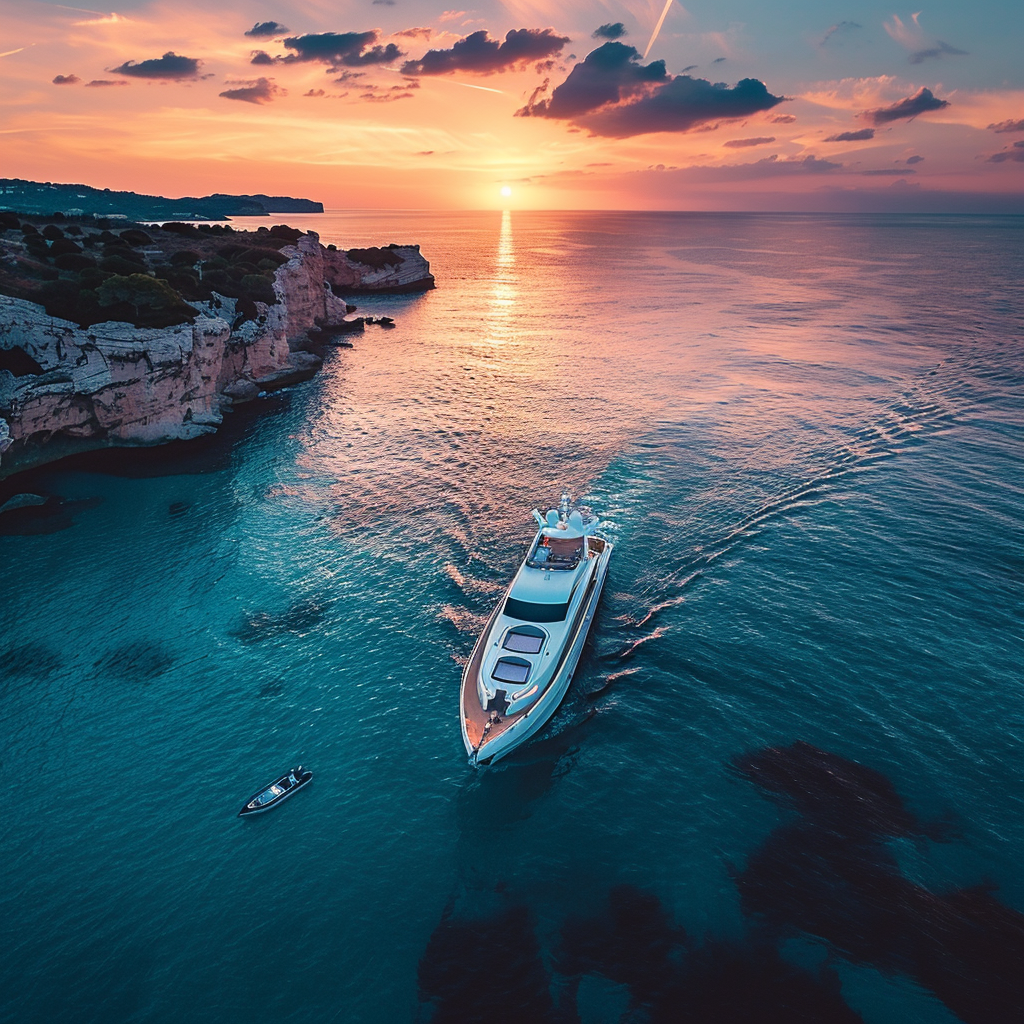
Why a Yacht Charter Is the Ultimate Vacation Experience
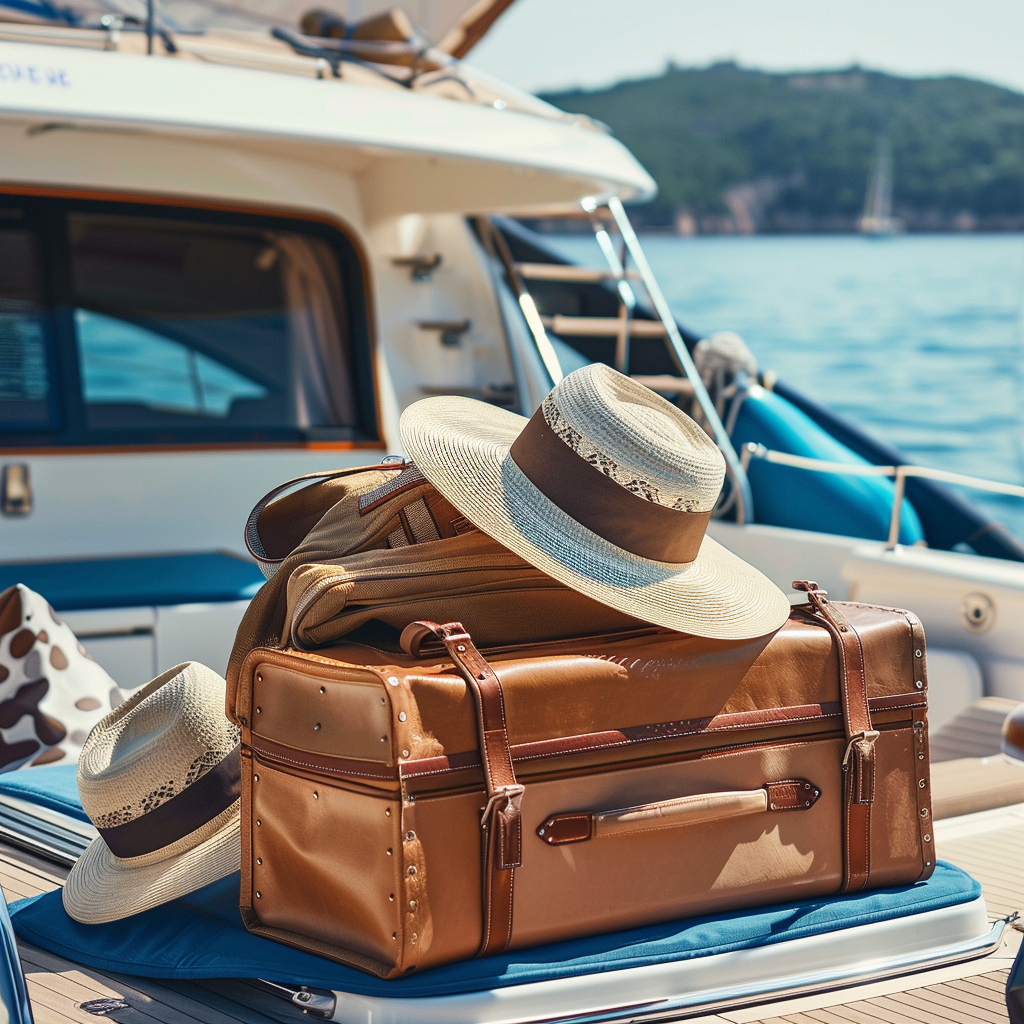
Top Tips for Packing for a Yacht Charter Vacation

Top Anchorages and Beaches in the British Virgin Islands for Yacht Charters

What Are Catamarans And Their History?
Catamarans are boats with two connected hulls that are joined by a bridge. Because they are faster, more stable, and capable of carrying larger cargo than their monohull counterparts, catamarans are growing in popularity.
As a result, designers and owners have greater freedom to accommodate space needs in terms of size and usefulness than they would with single-hulled vessels.
The name catamaran came from the Tamil word “kattumaram” which basically meant “logs which were bound together”. These traditional watercraft were basically used on the south coast of India and Srilanka. They were dated back to as early as the 5th century when they were used to transport troops from one island to another.
Let us get into more details to learn more about the different types of catamarans and their functions.
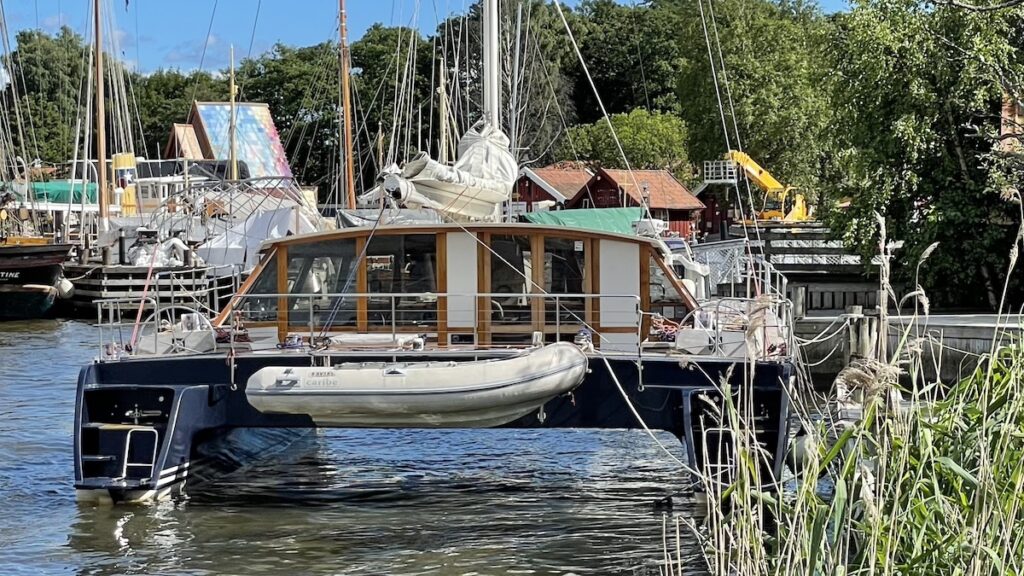
What are the different types of catamarans?
Catamarans are mainly divided into two categories: sailing and power catamarans, however, both categories can be split into smaller groups by their size and use.
Sailing catamarans
These types of catamarans are mainly propelled with help of sails. The sails act as wings with which the vessel moves forward with the help of wind energy. The sailing catamarans have advanced significantly in recent years in terms of both design and performance attributes. Sailing catamarans are further subdivided based on their dimensions and functions and are classified into,
Small, mini, or sports catamarans
Depending on the size, these are also known as leisure catamarans and can carry a load of 6 persons on average. You’ve definitely seen some of them speeding through your local beach waters on hot, sunny weekends; some of them are made to be driven by one person. Those designed for use in sports have a trapeze that enables one to hike out and serve as a counterweight.
Small-day sailing cats are well-liked because they offer a secure and straightforward learning environment, and you can see fleets of them in resorts where guests with little to no sailing experience utilize them. These little cats are often made of roto-molded plastic or fiberglass, and as they frequently lack auxiliary motors, sails are their only means of propulsion
A trampoline that spans the two hulls of the sports catamarans acts as a bridge so that individuals can move from one to the other without falling into the water. They may be launched and landed from a beach as opposed to a dock because of their modest size. They have a rotating mast and a mainsail with full-length battens.
Cruising Catamarans
In the worlds of long-distance cruising and bareboat chartering, larger cruising cats have dominated. These are more stable than their monohull competitors, allowing them to securely transport people across continents. These are more stable than their monohull competitors, allowing them to securely transport people across continents.
For maneuverability, charter cats frequently have two engines—one in each hull—as well as a mast that holds a mainsail and at least one headsail.
Nowadays, cruising catamarans are more widely available than monohulls at bareboat charter firms with tropical bases, and those numbers are rising in places like the Mediterranean.
Power catamarans
Power catamarans, often known as “multi-hull powerboats” or “power cats,” are vessels without masts or sails but with larger and more powerful engines. They can be the most perfect choice for your first boat if you enjoy offshore fishing or other water sports. You get a great balance of performance, stability, and maneuverability with these powerboats. Power cats come in a range of different sizes and shapes. In terms of dimensions and functions, they are also divided into,
Center console fishing catamarans
The fishing industry is flooded with smaller power cat brands, while bareboat charter and cruise platforms are seeing the emergence of larger ones. The multi-hull performance boat frequently has a center console driver layout. They can reach higher top speeds thanks to their higher horsepower, but these cats also need to be strengthened hulls to support the weight and power of these engines.
When used for fishing, normally lesser than 50 ft, there are several options available for live wells, rod holders, gear storage, and built-in coolers for both fish and beverages. Depending on the length and design elements of the boat, certain consoles may locate closer to the bow or aft of the vessel.
Offshore powerboat racing catamarans
Offshore powerboat racing is the aquatic equivalent of off-road auto racing. Since its inception in the late 1960s, offshore racing has changed drastically.
Though V-bottom powerboat classes still exist, twin-engine catamarans with top speeds of 170 MPH in the most powerful classes dominate the sport.
The offshore race course may be the most dynamic setting in all of the motorsports because of the constant fluctuations in a swell, wind, tide, current, and other factors. The track might abruptly change from being friendly to antagonistic.
These boats are designed and built such that they are both lightweight but extremely strong using the most advanced materials like carbon fiber and Kevlar . Manufacturing methods such as infusion are adopted to make sure the properties of the materials are not lost during the production stages.
Motor yachts and ferries
For their roominess and speed, catamaran designs have also become popular among motor yachts and commercial passenger ferries. These cruise-centric yachts offer homelike livability for avid travelers, are fuel efficient, and are fairly intuitive to run.
Motor yacht catamarans have been designed with larger living spaces in mind, as well as more outdoor recreation places. The huge fly bridges provide additional space for relaxing and socializing, and electric boat davits make lifting the dinghy simple. Daily tasks like cooking can be done with ease because catamarans don’t heel.
Why Is There A Shift In Trend From Monohulls To Catamarans?
Recently, more and more often you can find catamarans in the harbors of large cities and small resorts. It can be unequivocally argued that catamarans are gaining popularity among both beginners and experienced sailors and even celebrities. But what makes them gain this popularity?
Catamarans In Terms Of Function And Utility
The enormous interior space expansion can provide the owners considerably more freedom to select furnishings without regard to size limits and more room for additional appliances like washers and dryers, which can make life on board much easier.
Due to their broader decks and roomier interiors, catamarans are frequently employed as party boats. The deck can accommodate more people without giving them the impression of being crammed into a small space.
In terms of storage, catamarans offer more alternatives than monohulls because both hulls can serve a variety of purposes, increasing the vessel’s overall capacity as well.
Catamarans are typically utilized as party boats since they have bigger deck spaces and greater room for movement. The deck can also accommodate more people without giving them the impression of being confined in a small space.
If any equipment breaks down, there is always a backup. For instance, if one of the engines on the port hull fails, we can always use the starboard engine to re-enter landfall. Likewise, if a generator breaks down, there is always a second generator that can be utilized as a backup.
Catamarans In Terms Of Performance And Stability
Due to the narrow hulls of catamarans, which serve to reduce drag forces, they frequently outperform monohulls. On performance power catamarans, the area in between the two hulls known as the “Tunnel” is built in a similar way to an aerofoil so that it behaves like a wing, boosting the aerodynamic lift forces and enhancing the overall effectiveness and top-end speeds of the craft.
Due to their stronger lift forces and lower water friction than monohulls, catamarans typically have a better fuel economy. This is because the strain placed on the engines as a whole is reduced, resulting in less fuel being used.
In terms of roll stability, catamarans are often more stable than monohulls. This offers them an advantage in terms of comfort and the ability to carry out various activities onboard the vessel with ease, as well as lowering the possibility of passengers falling on board. Because they are less likely to make passengers seasick, catamarans are typically used as ferries or passenger ships.
Catamarans provide a more comfortable ride whether they are in shallow water, deep water, or at anchor; they have a decreased chance of keeling over or capsizing in heavy winds.
Also, catamarans have a much lower draft when compared to their mono hull counterpart’s allowing them to easily ply over shallower waters.
What Are The Potential Drawbacks Of Catamarans?
Catamarans have a few minor limitations, much like any other kind of boat:
Finding dock space is frequently challenging and expensive for catamarans because they take up more room.
Power and sailing cats can both smash into the bridge deck when heading to the weather because of the way that they are built.
Additionally, because they have two hulls instead of one, sailing cats can’t necessarily aim as high into the wind as monohulls can.
Overall, a catamaran allows for greater speeds, but at the expense of much-reduced vessel control. Knowing when to accelerate and when to slow down is difficult when sailing a catamaran. A catamaran can be readily overturned in sea conditions that a monohull can maneuver securely in.
Finally, while it may be alluring to add more weight in a catamaran due to the space it provides, doing so will almost certainly degrade the performance of either power or sailing cat—something that is less of an issue on their monohull counterparts.
Catamarans are a growing trend due to their better advantages over their monohull counterparts. Despite having an ancient fundamental design, catamarans are a modern boating alternative that can be used by any boater for both commercial and leisure uses.
- Recent Posts
- The Role of Cargo Ships in Global Trade – August 22, 2024
- Report: Yang Ming’s YM Mobility Explosion at Ningbo-Zhoushan Port – August 9, 2024
- Understanding Drillships: Types, Key Features and Advancements – August 1, 2024
About the author
I worked as an officer in the deck department on various types of vessels, including oil and chemical tankers, LPG carriers, and even reefer and TSHD in the early years. Currently employed as Marine Surveyor carrying cargo, draft, bunker, and warranty survey.
Latest posts

The Role of Cargo Ships in Global Trade
Contents show Volume of Goods Transported by Sea Key Global Trade Routes Economic Impact of Maritime Shipping Types of Cargo Commonly Transported Environmental Considerations Conclusion Cargo ships are the lifeline […]

What Are AGVs? Automation Becoming Increasingly Common in Seaports
What are AGVs? Automated guided vehicles can minimize the troubles of manual operations and enhance seaport operations.
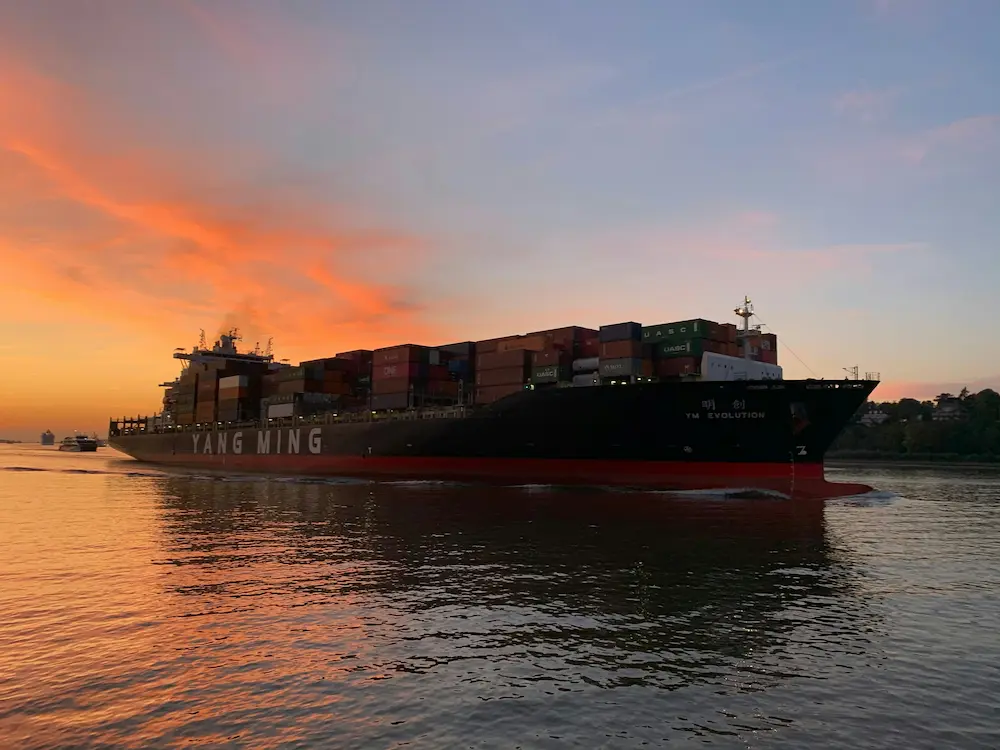
Report: Yang Ming’s YM Mobility Explosion at Ningbo-Zhoushan Port
A massive explosion occurred on the container ship YM Mobility while it was berthed at the Ningbo-Zhoushan Port in China

A catamaran ( / ˌ k æ t ə m ə ˈ r æ n / ) (informally, a "cat") is a watercraft with two parallel hulls of equal size. The distance between a catamaran's hulls imparts resistance to rolling and overturning. Catamarans typically have less hull volume, smaller displacement , and shallower draft (draught) than monohulls of comparable length. The two hulls combined also often have a smaller hydrodynamic resistance than comparable monohulls, requiring less propulsive power from either sails or motors. The catamaran's wider stance on the water can reduce both heeling and wave-induced motion, as compared with a monohull, and can give reduced wakes.
Development in Austronesia
Traditional catamarans, western development of sailing catamarans, performance, swath and wave-piercing designs, applications, passenger transport, further reading.
Catamarans were invented by the Austronesian peoples , and enabled their expansion to the islands of the Indian and Pacific Oceans . [1]
Catamarans range in size from small sailing or rowing vessels to large naval ships and roll-on/roll-off car ferries. The structure connecting a catamaran's two hulls ranges from a simple frame strung with webbing to support the crew to a bridging superstructure incorporating extensive cabin and/or cargo space.
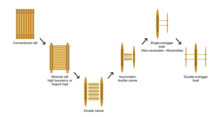
Catamarans from Oceania and Maritime Southeast Asia became the inspiration for modern catamarans. Until the 20th century catamaran development focused primarily on sail-driven concepts.
The word "catamaran" is derived from the Tamil word, kattumaram (கட்டுமரம்), which means "logs bound together" and is a type of single-hulled raft made of three to seven tree trunks lashed together. The term has evolved in English usage to refer to unrelated twin-hulled vessels. [2] [3] [4]

Catamaran-type vessels were an early technology of the Austronesian peoples . Early researchers like Heine-Geldern (1932) and Hornell (1943) once believed that catamarans evolved from outrigger canoes , but modern authors specializing in Austronesian cultures like Doran (1981) and Mahdi (1988) now believe it to be the opposite. [5] [6] [1]

Two canoes bound together developed directly from minimal raft technologies of two logs tied together. Over time, the twin-hulled canoe form developed into the asymmetric double canoe, where one hull is smaller than the other. Eventually the smaller hull became the prototype outrigger , giving way to the single outrigger canoe, then to the reversible single outrigger canoe. Finally, the single outrigger types developed into the double outrigger canoe (or trimarans ). [5] [6] [1]
This would also explain why older Austronesian populations in Island Southeast Asia tend to favor double outrigger canoes, as it keeps the boats stable when tacking . But they still have small regions where catamarans and single-outrigger canoes are still used. In contrast, more distant outlying descendant populations in Oceania , Madagascar , and the Comoros , retained the twin-hull and the single outrigger canoe types, but the technology for double outriggers never reached them (although it exists in western Melanesia ). To deal with the problem of the instability of the boat when the outrigger faces leeward when tacking, they instead developed the shunting technique in sailing, in conjunction with reversible single-outriggers. [5] [6] [1] [7] [8]
Despite their being the more "primitive form" of outrigger canoes, they were nonetheless effective, allowing seafaring Polynesians to voyage to distant Pacific islands . [9]
The following is a list of traditional Austronesian catamarans:
- Island Melanesia :
- Fiji : Drua (or waqa tabu )
- Papua New Guinea : Lakatoi
- Tonga : Hamatafua , kalia , tongiaki
- Cook Islands : Vaka katea
- Hawaii : Waʻa kaulua
- Marquesas : Vaka touʻua
- New Zealand : Waka hourua
- Samoa : ʻAlia , amatasi , va'a-tele
- Society Islands : Pahi , tipairua
The first documented example of twin-hulled sailing craft in Europe was designed by William Petty in 1662 to sail faster, in shallower waters, in lighter wind, and with fewer crew than other vessels of the time. However, the unusual design met with skepticism and was not a commercial success. [10] [11]

The design remained relatively unused in the West for almost 160 years until the early 19th-century, when the Englishman Mayflower F. Crisp built a two-hulled merchant ship in Rangoon, Burma . The ship was christened Original . Crisp described it as "a fast sailing fine sea boat; she traded during the monsoon between Rangoon and the Tenasserim Provinces for several years". [12] [13]
Later that century, the American Nathanael Herreshoff constructed a twin-hulled sailing boat of his own design (US Pat. No. 189,459). [14] The craft, Amaryllis , raced at her maiden regatta on June 22, 1876, and performed exceedingly well. Her debut demonstrated the distinct performance advantages afforded to catamarans over the standard monohulls. It was as a result of this event, the Centennial Regatta of the New York Yacht Club, that catamarans were barred from regular sailing classes, and this remained the case until the 1970s. [15] On June 6, 1882, three catamarans from the Southern Yacht Club of New Orleans raced a 15 nm course on Lake Pontchartrain and the winning boat in the catamaran class, Nip and Tuck , beat the fastest sloop's time by over five minutes. [16] [17]
In 1916, Leonardo Torres Quevedo patented a multihull steel vessel named Binave (Twin Ship), a new type of catamaran which was constructed and tested in Bilbao ( Spain ) in 1918. The innovative design included two 30 HP Hispano-Suiza marine engines and could modify its configuration when sailing , positioning two rudders at the stern of each float, with the propellers also placed aft . [18] [19] [20] In 1936, Eric de Bisschop built a Polynesian "double canoe" in Hawaii and sailed it home to a hero's welcome in France. In 1939, he published his experiences in a book, Kaimiloa , which was translated into English in 1940. [21]
Roland and Francis Prout experimented with catamarans in 1949 and converted their 1935 boat factory in Canvey Island , Essex (England), to catamaran production in 1954. Their Shearwater catamarans easily won races against monohulls. Yellow Bird, a 1956-built Shearwater III , raced successfully by Francis Prout in the 1960s, is in the collection of the National Maritime Museum Cornwall . [22] Prout Catamarans , Ltd. designed a mast aft rig with the mast aft of midships to support an enlarged jib—more than twice the size of the design's reduced mainsail; it was produced as the Snowgoose model. [23] The claimed advantage of this sail plan was to diminish any tendency for the bows of the vessel to dig in. [24] [25]

In the mid-twentieth century, beachcats became a widespread category of sailing catamarans, owing to their ease of launching and mass production. In California, a maker of surfboards , Hobie Alter , produced the 250-pound (110 kg) Hobie 14 in 1967, and two years later the larger and even more successful Hobie 16 . As of 2016, the Hobie 16 was still being produced with more than 100,000 having been manufactured. [26]
Catamarans were introduced to Olympic sailing in 1976. The two-handed Tornado catamaran was selected for the multihull discipline in the Olympic Games from 1976 through 2008. It was redesigned in 2000. [27] The foiling Nacra 17 was used in the Tokyo 2020 Olympics, which were held in 2021; [28] [29] after the 2015 adoption of the Nacra 15 as a Youth World Championships class and as a new class for the Youth Olympic Games. [30] [31]

Catamarans have two distinct primary performance characteristics that distinguish them from displacement monohull vessels: lower resistance to passage through the water and greater stability (initial resistance to capsize). Choosing between a monohull and catamaran configuration includes considerations of carrying capacity, speed, and efficiency.
At low to moderate speeds, a lightweight catamaran hull experiences resistance to passage through water that is approximately proportional to its speed. A displacement monohull, by comparison, experiences resistance that is at least the square of its speed. This means that a catamaran would require four times the power in order to double its speed, whereas a monohull would require eight times the power to double its speed, starting at a slow speed. [32] For powered catamarans, this implies smaller power plants (although two are typically required). For sailing catamarans, low forward resistance [33] allows the sails to derive power from attached flow , [34] their most efficient mode—analogous to a wing—leading to the use of wingsails in racing craft. [35]
Catamarans rely primarily on form stability to resist heeling and capsize. [32] Comparison of heeling stability of a rectangular-cross section monohull of beam, B , compared with two catamaran hulls of width B /2, separated by a distance, 2× B , determines that the catamaran has an initial resistance to heeling that is seven times that of the monohull. [36] Compared with a monohull, a cruising catamaran sailboat has a high initial resistance to heeling and capsize—a fifty-footer requires four times the force to initiate a capsize than an equivalent monohull. [37]

One measure of the trade-off between speed and carrying capacity is the displacement Froude number (Fn V ) , [38] compared with calm water transportation efficiency . [39] Fn V applies when the waterline length is too speed-dependent to be meaningful—as with a planing hull. [40] It uses a reference length, the cubic root of the volumetric displacement of the hull, V , where u is the relative flow velocity between the sea and ship, and g is acceleration due to gravity :

Calm water transportation efficiency of a vessel is proportional to the full-load displacement and the maximum calm-water speed, divided by the corresponding power required. [41]
Large merchant vessels have a Fn V between one and zero, whereas higher-performance powered catamarans may approach 2.5, denoting a higher speed per unit volume for catamarans. Each type of vessel has a corresponding calm water transportation efficiency, with large transport ships being in the range of 100–1,000, compared with 11-18 for transport catamarans, denoting a higher efficiency per unit of payload for monohulls. [39]
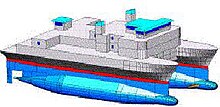
Two advances over the traditional catamaran are the small-waterplane-area twin hull (SWATH) and the wave-piercing configuration—the latter having become a widely favored design.
SWATH reduces wave-generating resistance by moving displacement volume below the waterline, using a pair of tubular, submarine-like hulls, connected by pylons to the bridge deck with a narrow waterline cross-section. The submerged hulls are minimally affected by waves. [42] The SWATH form was invented by Canadian Frederick G. Creed , who presented his idea in 1938 and was later awarded a British patent for it in 1946. It was first used in the 1960s and 1970s as an evolution of catamaran design for use as oceanographic research vessels or submarine rescue ships. [43] In 1990, the US Navy commissioned the construction of a SWATH ship to test the configuration. [44]
SWATH vessels compare with conventional powered catamarans of equivalent size, as follows: [42]
- Larger wetted surface, which causes higher skin friction drag
- Significant reduction in wave-induced drag, with the configuration of struts and submerged hull structures
- Lower water plane area significantly reduces pitching and heaving in a seaway
- No possibility of planing
- Higher sensitivity to loading, which may bring the bridge structure closer to the water

Wave-piercing catamarans (strictly speaking they are trimarans , with a central hull and two outriggers) employ a low-buoyancy bow on each hull that is pointed at the water line and rises aft, up to a level, to allow each hull to pierce waves, rather than ride over them. This allows higher speeds through waves than for a conventional catamaran. They are distinguished from SWATH catamarans, in that the buoyant part of the hull is not tubular. The spanning bridge deck may be configured with some of the characteristics of a normal V-hull, which allows it to penetrate the crests of waves. [45]
Wave-piercing catamaran designs have been employed for yachts, [46] passenger ferries, [47] and military vessels. [48]

A catamaran configuration fills a niche where speed and sea-kindliness is favored over bulk capacity. In larger vessels, this niche favors car ferries and military vessels for patrol or operation in the littoral zone.

Recreational and sport catamarans typically are designed to have a crew of two and be launched and landed from a beach. Most have a trampoline on the bridging structure, a rotating mast and full-length battens on the mainsail. Performance versions often have trapezes to allow the crew to hike out and counterbalance capsize forces during strong winds on certain points of sail. [49]
For the 33rd America's Cup , both the defender and the challenger built 90-foot (27 m) long multihulls. Société Nautique de Genève , defending with team Alinghi , sailed a catamaran. The challenger, BMW Oracle Racing, used a trimaran, replacing its soft sail rig with a towering wing sail —the largest sailing wing ever built. In the waters off Valencia , Spain in February 2010, the BMW Oracle Racing trimaran with its powerful wing sail proved to be superior. This represented a break from the traditional monohulls that had always been sailed in previous America's Cup series. [50]
On San Francisco Bay, the 2013 America's Cup was sailed in 72-foot (22 m) long AC72 catamarans (craft set by the rules for the 2013 America's Cup). Each yacht employed hydrofoils and a wing sail. The regatta was won 9–8 by Oracle Team USA against the challenger, Emirates Team New Zealand , in fifteen matches because Oracle Team USA had started the regatta with a two-point penalty. [51] [52]
Yachting has seen the development of multihulls over 100 feet (30 m) in length. " The Race " helped precipitate this trend; it was a circumnavigation challenge which departed from Barcelona, Spain, on New Year's Eve, 2000. Because of the prize money and prestige associated with this event, four new catamarans (and two highly modified ones) over 100 feet (30 m) in length were built to compete. The largest, PlayStation , owned by Steve Fossett , was 125 feet (38 m) long and had a mast which was 147 feet (45 m) above the water. Virtually all of the new mega-cats were built of pre-preg carbon fiber for strength and the lowest possible weight. The top speeds of these boats can approach 50 knots (58 mph; 93 km/h) . The Race was won by the 33.50 m (109.9 ft) -long catamaran Club Med skippered by Grant Dalton . It went round the globe in 62 days at an average speed of 18 knots (21 mph; 33 km/h) . [53]

Whitewater catamaran—sometimes called "cata-rafts"—for whitewater sports are widely spread in post-Soviet countries . They consists of two inflatable hulls connected with a lattice scaffold. The frame of the tourist catamaran can be made of both aluminum (duralumin) pipes and from felled tree trunks. The inflatable part has two layers—an airtight balloon with inflation holes and a shell made of dense tissue, protecting the balloon from mechanical damage. Advantages of such catamarans are light weight, compactness and convenience in transportation (the whole product is packed in one pack-backpack, suitable for air traffic standards) and the speed of assembly (10–15 minutes for the inflation). [54] All-inflatable models are available in North America. [55] A cata-raft design has been used on the Colorado River to handle heavy whitewater, yet maintain a good speed through the water. [56]

Cruising sailors must make trade-offs among volume, useful load, speed, and cost in choosing a boat. Choosing a catamaran offers increased speed at the expense of reduced load per unit of cost. Howard and Doane describe the following tradeoffs between cruising monohulls and catamarans: [37] A long-distance, offshore cruising monohull may be as short as 30 feet (9.1 m) for a given crew complement and supporting supplies, whereas a cruising catamaran would need to be 40 feet (12 m) to achieve the same capacity. In addition to greater speed, catamarans draw less water than do monohulls— as little as 3 feet (0.91 m) —and are easier to beach. Catamarans are harder to tack and take up more space in a marina. Cruising catamarans entail added expense for having two engines and two rudders. Tarjan adds that cruising catamarans boats can maintain a comfortable 300 nautical miles (350 mi; 560 km) per day passage, with the racing versions recording well over 400 nautical miles (460 mi; 740 km) per day. In addition, they do not heel more than 10-12 degrees, even at full speed on a reach. [57]
Powered cruising catamarans share many of the amenities found in a sail cruising catamaran. The saloon typically spans two hulls wherein are found the staterooms and engine compartments. As with sailing catamarans, this configuration minimizes boat motion in a seaway. [58]
The Swiss-registered wave-piercing catamaran, Tûranor PlanetSolar , which was launched in March 2010, is the world's largest solar powered boat. It completed a circumnavigation of the globe in 2012. [59]

The 1970s saw the introduction of catamarans as high-speed ferries , as pioneered by Westermoen Hydrofoil in Mandal , Norway, which launched the Westamaran design in 1973. [60] The Stena Voyager was an example of a large, fast ferry, typically traveling at a speed of 46 miles per hour (74 km/h) , although it was capable of over 70 miles per hour (110 km/h) . [61]
The Australian island Tasmania became the site of builders of large transport catamarans— Incat in 1977 [62] and Austal in 1988 [63] —each building civilian ferries and naval vessels. Incat built HSC Francisco , a High-Speed trimaran that, at 58 knots, is (as of 2014) the fastest passenger ship in service. [64]

The first warship to be propelled by a steam engine, named Demologos or Fulton and built in the United States during the War of 1812 , was a catamaran with a paddle wheel between her hulls.
In the early 20th Century several catamarans were built as submarine salvage ships: SMS Vulkan and SMS Cyclop of Germany , Kommuna of Russia , and Kanguro of Spain , all designed to lift stricken submarines by means of huge cranes above a moon pool between the hulls. Two Cold War-era submarine rescue ships , USS Pigeon and USS Ortolan of the US Navy , were also catamarans, but did not have the moon pool feature.
The use of catamarans as high-speed naval transport was pioneered by HMAS Jervis Bay , which was in service with the Royal Australian Navy between 1999 and 2001. The US Military Sealift Command now operates several Expeditionary Fast Transport catamarans owned by the US Navy; [65] they are used for high speed transport of military cargo, and to get into shallow ports.
The Makar -class is a class of two large catamaran-hull survey ships built for the Indian Navy . As of 2012, one vessel, INS Makar (J31) , was in service and the second was under construction. [66]
First launched in 2004 at Shanghai, the Houbei class missile boat of the People's Liberation Army Navy (PLAN) has a catamaran design to accommodate the vessel's stealth features. [67]
The Tuo Chiang-class corvette is a class of Taiwanese -designed fast and stealthy multi-mission wave-piercing catamaran corvettes [68] first launched in 2014 for the Republic of China (Taiwan) Navy .
- List of multihulls
Related Research Articles
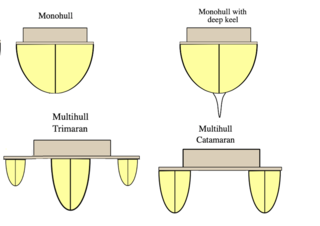
A multihull is a boat or ship with more than one hull, whereas a vessel with a single hull is a monohull. The most common multihulls are catamarans, and trimarans. There are other types, with four or more hulls, but such examples are very rare and tend to be specialised for particular functions.
A sailboat or sailing boat is a boat propelled partly or entirely by sails and is smaller than a sailing ship. Distinctions in what constitutes a sailing boat and ship vary by region and maritime culture.

A trimaran is a multihull boat that comprises a main hull and two smaller outrigger hulls which are attached to the main hull with lateral beams. Most modern trimarans are sailing yachts designed for recreation or racing; others are ferries or warships. They originated from the traditional double-outrigger hulls of the Austronesian cultures of Maritime Southeast Asia; particularly in the Philippines and Eastern Indonesia, where it remains the dominant hull design of traditional fishing boats. Double-outriggers are derived from the older catamaran and single-outrigger boat designs.

An outrigger is a projecting structure on a boat, with specific meaning depending on types of vessel. Outriggers may also refer to legs on a wheeled vehicle that are folded out when it needs stabilization, for example on a crane that lifts heavy loads.
A monohull is a type of boat having only one hull, unlike multihulled boats which can have two or more individual hulls connected to one another.
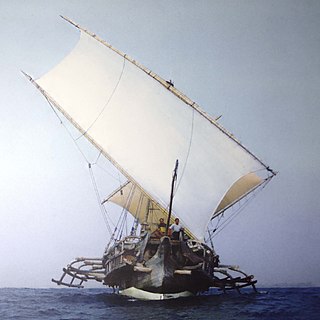
Outrigger boats are various watercraft featuring one or more lateral support floats known as outriggers, which are fastened to one or both sides of the main hull. They can range from small dugout canoes to large plank-built vessels. Outrigger boats can also vary in their configuration, from the ancestral double-hull configuration (catamarans), to single-outrigger vessels prevalent in the Pacific Islands and Madagascar, to the double-outrigger vessels (trimarans) prevalent in Island Southeast Asia. They are traditionally fitted with Austronesian sails, like the crab claw sails and tanja sails, but in modern times are often fitted with petrol engines.

Proas are various types of multi-hull outrigger sailboats of the Austronesian peoples. The terms were used for native Austronesian ships in European records during the Colonial era indiscriminately, and thus can confusingly refer to the double-ended single-outrigger boats of Oceania, the double-outrigger boats of Island Southeast Asia, and sometimes ships with no outriggers or sails at all.
A small waterplane area twin hull , better known by the acronym SWATH , is a catamaran design that minimizes hull cross section area at the sea's surface. Minimizing the ship's volume near the surface area of the sea, where wave energy is located, minimizes a vessel's response to sea state, even in high seas and at high speeds. The bulk of the displacement necessary to keep the ship afloat is located beneath the waves, where it is less affected by wave action. Wave excitation drops exponentially as depth increases, so wave action normally does not affect a submerged submarine at all. Placing the majority of a ship's displacement under the waves is similar in concept to creating a ship that rides atop twin submarines.

Hobie Cat is a company that manufactures watercraft and other products as the Hobie Cat Company. "Hobie Cat" can also refer to specific products of the company, notably its sailing catamarans. Its fiberglass catamaran models range in nominal length between 14 feet (4.3 m) and 18 feet (5.5 m). Rotomolded catamaran models range in length between 12 feet (3.7 m) and 17 feet (5.2 m). Other sailing vessels in the Hobie Cat lineup include, monocats, dinghies, and trimarans, ranging in length between 9 feet (2.7 m) and 20 feet (6.1 m). Its largest product was the Hobie 33, 33 feet (10 m) in length. The company's non-sailing product line includes surfboards, kayaks, stand-up paddle boards, pedalboards, eyeware, and e-bikes. It was founded in 1961 by Hobart (Hobie) Alter, who originally manufactured surfboards.
Canoe sailing refers to the practice of fitting an Austronesian outrigger or Western canoe with sails.
The term beachcat is an informal name for one of the most common types of small recreational sailboats, minimalist 14 to 20 foot catamarans, almost always with a cloth "trampoline" stretched between the two hulls, typically made of fiberglass or more recently rotomolded plastic. The name comes from the fact that they are designed to be sailed directly off a sand beach, unlike most other small boats which are launched from a ramp. The average 8 foot width of the beachcat means it can also sit upright on the sand and is quite stable in this position, unlike a monohull of the same size. The Hobie 14 and Hobie 16 are two of the earliest boats of this type that achieved widespread popularity, and popularized the term as well as created the template for this type of boat.

A wave-piercing boat hull has a very fine bow, with reduced buoyancy in the forward portions. When a wave is encountered, the lack of buoyancy means the hull pierces through the water rather than riding over the top, resulting in a smoother ride than traditional designs, and in diminished mechanical stress on the vessel. It also reduces a boat's wave-making resistance.

A sailing hydrofoil , hydrofoil sailboat , or hydrosail is a sailboat with wing-like foils mounted under the hull. As the craft increases its speed the hydrofoils lift the hull up and out of the water, greatly reducing wetted area, resulting in decreased drag and increased speed. A sailing hydrofoil can achieve speeds exceeding double and in some cases triple the wind speed.

A sailing yacht , is a leisure craft that uses sails as its primary means of propulsion. A yacht may be a sail or power vessel used for pleasure, cruising, or racing. There is no standard definition, so the term applies here to sailing vessels that have a cabin with amenities that accommodate overnight use. To be termed a "yacht", as opposed to a "boat", such a vessel is likely to be at least 33 feet (10 m) in length and have been judged to have good aesthetic qualities. Sailboats that do not accommodate overnight use or are smaller than 30 feet (9.1 m) are not universally called yachts. Sailing yachts in excess of 130 feet (40 m) are generally considered to be superyachts.
VPLP design is a French-based naval architectural firm founded by Marc Van Peteghem and Vincent Lauriot-Prévost, responsible for designing some of the world's most innovative racing boats. Their designs presently hold many of the World Speed Sailing records.
James Wharram was a British multihull pioneer and designer of catamarans.
The Ocean Bird is a class of trimaran sailboat designed by John Westell and produced by Honnor Marine Ltd. at Totnes, Teignmouth in the 1970s, featuring fold-in lateral floats on a webless steel-beam frame chosen to provide stability against heeling, yet allow a compact footprint in harbour.
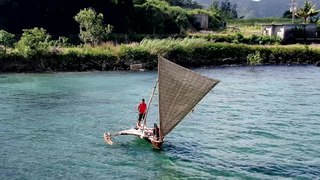
Kaep is a traditional type of double-ended Proa sailboat native to Palau. Some of the essential design elements have also been adopted as a modern smaller multihull prototype variant.

Polynesian multihull terminology , such as "ama", "aka" and "vaka" are multihull terms that have been widely adopted beyond the South Pacific where these terms originated. This Polynesian terminology is in common use in the Americas and the Pacific but is almost unknown in Europe, where the English terms "hull" and "outrigger" form normal parlance. Outriggers, catamarans, and outrigger boats are a common heritage of all Austronesian peoples and predate the Micronesian and Polynesian expansion into the Pacific. They are also the dominant forms of traditional ships in Island Southeast Asian and Malagasy Austronesian cultures, where local terms are used.

Austronesian vessels are the traditional seafaring vessels of the Austronesian peoples of Taiwan, Maritime Southeast Asia, Micronesia, coastal New Guinea, Island Melanesia, Polynesia, and Madagascar. They also include indigenous ethnic minorities in Vietnam, Cambodia, Myanmar, Thailand, Hainan, the Comoros, and the Torres Strait Islands.
- ↑ "Origin and meaning of catamaran" . Online Etymology Dictionary . Retrieved March 1, 2019 .
- ↑ Lück, Michael (2008). The Encyclopedia of Tourism and Recreation in Marine Environments . Wallingford, UK: CABI. p. 86. ISBN 978-1-84593-350-0 .
- ↑ "Catamaran" . Dictionary.com Unabridged . Random House, inc. 2016.
- 1 2 3 Mahdi, Waruno (1999). "The Dispersal of Austronesian boat forms in the Indian Ocean". In Blench, Roger; Spriggs, Matthew (eds.). Archaeology and Language III: Artefacts languages, and texts . One World Archaeology. Vol. 34. Routledge. pp. 144–179. ISBN 0415100542 .
- 1 2 3 Doran, Edwin B. (1981). Wangka: Austronesian Canoe Origins . Texas A&M University Press. ISBN 9780890961070 .
- ↑ Beheim, B. A.; Bell, A. V. (February 23, 2011). "Inheritance, ecology and the evolution of the canoes of east Oceania" . Proceedings of the Royal Society B: Biological Sciences . 278 (1721): 3089–3095. doi : 10.1098/rspb.2011.0060 . PMC 3158936 . PMID 21345865 .
- ↑ Hornell, James (1932). "Was the Double-Outrigger Known in Polynesia and Micronesia? A Critical Study". The Journal of the Polynesian Society . 41 (2 (162)): 131–143.
- ↑ Kirch, Patrick (2001). Hawaiki . Cambridge University Press. p. 80 . ISBN 978-0-521-78309-5 .
- ↑ "Model of a twin-hulled ship - William Petty" . Royal Society . Retrieved August 8, 2014 .
- ↑ "Sailing with an Achilles' keel | General" . Times Higher Education . September 22, 2000 . Retrieved August 8, 2014 .
- ↑ Bertie Reginald Pearn (1938). A History of Rangoon . Corporation of Rangoon. p. 136.
- ↑ M. F. Crisp (1849). A treatise on marine architecture, elucidating the theory of the resistance of water : illustrating the form, or model best calculated to unite velocity, buoyancy, stability, strength, etc., in the same vessel : and finally, adducing the theory of the art of shipbuilding . Maulmein: American Baptist mission press. p. 94.
- ↑ Nathanael Herreshoff (April 10, 1877). "US Patent Number 189459: Improvement in construction of sailing-vessels" .
- ↑ L. Francis Herreshoff. "The Spirit of the Times, November 24, 1877 (reprint)" . Marine Publishing Co., Camden, Maine. Archived from the original on January 24, 2008 . Retrieved December 2, 2014 .
- ↑ Sampsell, Lorillard D. (March 1898), "The Southern Yacht Club of New Orleans" , Outing: Sport, Adventure, Travel Fiction, Volume 31
- ↑ Counce, Oliver J. (2000), "The sesquicentennial of the Southern Yacht Club of New Orleans, 1849-1999 : 150 years of yachting in the Gulf South", Metairie Franklin Southland Printing , OCLC 46836336
- ↑ Aviación Digital (May 31, 2020). "La "Binave" de Torres Quevedo: El precursor de los modernos catamaranes" . Retrieved June 25, 2024 .
- ↑ Rodrigo Pérez Fernández. Francisco A. González Redondo. On the origin, foundational designs and first manufacture of the modern catamaran , International Journal of Maritime History , SAGE Publishing , Volume 34, Issue 3, February 1, 2022.
- ↑ Patentes de invención de Don Leonardo Torres Quevedo , España Registro de la Propiedad Industrial, 1988. ISBN 84-86857-50-3
- ↑ The Voyage of the Kaimiloa , London, 1940 (translated from French: Kaimiloa : D'Honolulu à Cannes par l'Australie et Le Cap, à bord d'une double pirogue polynésienne ), Editions Plon, Paris, 1939 ( Au delà des horizons lointains 1 ).
- ↑ Bird, Vanessa (2013). Classic Classes . A&C Black. p. 65. ISBN 9781408158906 . Retrieved January 27, 2016 .
- ↑ Charles E. Kanter (November 2001). "Reviewing the Prout Snowgoose 34 catamaran" . Southwinds Sailing . Archived from the original on May 19, 2006 . Retrieved February 27, 2019 .
- ↑ Sailor's multihull guide to the best cruising catamarans & trimarans . Jeffrey, Kevin, 1954-, Jeffrey, Nan, 1949-, Kanter, Charles E., 1930- (3rd ed.). Belfast, P.E.I.: Avalon House. 2002. ISBN 0962756288 . OCLC 51112242 . {{ cite book }} : CS1 maint: others ( link )
- ↑ Andrews, Jim (1974). Catamarans for cruising . London: Hollis and Carter. ISBN 0370103394 . OCLC 1273831 .
- ↑ "Hobie 16 2012 Class Report 2012" (PDF) . Retrieved October 1, 2015 .
- ↑ Forbes, John; Young, Jim (2003). "A Brief Tornado History—The Story of the Tornado, the Olympic Catamaran" . International Tornado Class Association . Retrieved January 27, 2016 . .
- ↑ Nelson, Gunnar (November 15, 2016). "World Sailing confirms Nacra 17 Foiling version for Tokyo 2020" . catsailingnews.com . Catamaran Racing News and Design . Retrieved August 21, 2017 .
- ↑ Wong, Jonathan (October 18, 2015). "Perfecting their craft" . The Straits Times . Singapore Press Holdings Ltd . Retrieved November 1, 2017 .
- ↑ "Youth World Sailing Championship – Multihull selection" . sailing.org.au . Australian Sailing . Retrieved August 21, 2017 .
- ↑ Johnson, Tim. "Nacra 15 selected as the next Youth multihull" . Yachts and Yachting .com . YY Online Services Ltd . Retrieved August 21, 2017 .
- 1 2 Garrett, Ross (January 1, 1996). The Symmetry of Sailing: The Physics of Sailing for Yachtsmen . Sheridan House, Inc. p. 133. ISBN 9781574090000 .
- ↑ Yang, C.; Löhner, R.; Soto, O. (August 22, 2001). "Optimization of a wave-cancellation multihull using CFD tools". In Wu, You-Sheng; Guo-Jun Zhou; Wei-Cheng Cui (eds.). Practical Design of Ships and Other Floating Structures: Eighth International Symposium . Vol. 1. China: Elsevier. ISBN 9780080539355 .
- ↑ Weltner, Klaus (January 1987). "A comparison of explanations of the aerodynamic lifting force". American Journal of Physics . 55 (1): 52. Bibcode : 1987AmJPh..55...50W . doi : 10.1119/1.14960 .
- ↑ Nielsen, Peter (May 14, 2014). "Have Wingsails Gone Mainstream?" . Sail Magazine . Interlink Media . Retrieved January 24, 2015 .
- ↑ Biran, Adrian; Pulido, Ruben Lopez (2013). Ship Hydrostatics and Stability (2 ed.). Butterworth-Heinemann. p. 67. ISBN 978-0080982908 .
- 1 2 Howard, Jim; Doane, Charles J. (2000). Handbook of Offshore Cruising: The Dream and Reality of Modern Ocean Cruising . Sheridan House, Inc. pp. 36–8. ISBN 1574090933 . Retrieved January 27, 2016 .
- ↑ Newman, John Nicholas (1977). Marine hydrodynamics . Cambridge, Massachusetts: MIT Press . p. 28 . ISBN 0-262-14026-8 . .
- 1 2 Watson, D. G. M. (2002). Practical Ship Design . Elsevier Ocean Engineering Book Series. Vol. 1 (Revised ed.). Gulf Professional Publishing. pp. 47–48. ISBN 0080440541 . See Fig. 2.1 'Slender' and 'Swath' figures.
- ↑ Wilson, F.W.; Vlars, P.R. (September 1981). "Operational Characteristics Comparisons" . AIAA 6th Marine Systems Conference . American Institute of Aeronautics and Astronautics: 11 . Retrieved March 31, 2017 .
- ↑ Eames, Michael C. (April 15, 1980). "Advances is Naval Architecture for Surface Naval Ships" (PDF) . Proceedings . London: Royal Institution of Naval Architects: 31. Archived from the original (PDF) on February 1, 2016 . Retrieved January 31, 2016 .
- 1 2 Misra, Suresh Chandra (2015). Design Principles of Ships and Marine Structures . CRC Press. ISBN 978-1482254471 . Retrieved January 27, 2016 .
- ↑ Helfers, John (2006). The Unauthorized Dan Brown Companion . Kensington Publishing Corp. p. 271. ISBN 0806535806 . Retrieved January 27, 2016 .
- ↑ Jane's high-speed marine craft (24 ed.). Jane's Information Group. 1991. ISBN 0710612664 . Retrieved January 27, 2016 .
- ↑ Husick, Charles B. (2009). Chapman Piloting, Seamanship and Small Boat Handling . Sterling Publishing Company, Inc. p. 16. ISBN 9781588167446 . Retrieved January 26, 2016 .
- ↑ Caprio, Dennis (July 2001). "Loomes 83" . Yachting . Vol. 190, no. 1. pp. 81–84. ISSN 0043-9940 . Retrieved January 26, 2016 .
- ↑ Yun, Liang; Bliault, Alan (July 8, 2014). High Performance Marine Vessels . Springer Science & Business Media. p. 206. ISBN 978-1-4614-0868-0 . Retrieved January 26, 2016 .
- ↑ Brumley, Jeff (October 5, 2011). "Unusual ship visits Mayport after 6-month deployment to African waters" . Florida Times-Union . Jacksonville . Retrieved January 26, 2016 .
- ↑ Berman, Phil (March 1982). Catamaran Sailing: From Start to Finish . W. W. Norton & Co. Inc. ISBN 978-0393000849 .
- ↑ "BMW Oracle wins America's Cup" . ESPN. Associated Press. February 14, 2010 . Retrieved January 27, 2016 .
- ↑ "Ben Ainslie's USA beat Team New Zealand in decider" . BBC Sport . September 26, 2013 . Retrieved September 26, 2013 .
- ↑ "Oracle Team USA completes greatest comeback in America's Cup history, defeating Emirates New Zealand" . New York Daily News . September 25, 2013. Archived from the original on September 29, 2013 . Retrieved September 26, 2013 .
- ↑ Zimmermann, Tim (2004). The Race: Extreme Sailing and Its Ultimate Event: Nonstop, Round-the-World, No Holds Barred . Houghton Mifflin Harcourt. ISBN 0547347065 .
- ↑ Fox, Peter (May 26, 2016). "Cataraft Testing on the Clackamas River" . Northwest Rafting Company . Retrieved March 3, 2019 .
- ↑ Steelhammer, Rick. "WV guides on US team in world whitewater rafting championship" . Charleston Gazette-Mail . Retrieved March 3, 2019 .
- ↑ Lindeman, Phil (January 31, 2017). "Take 5: On the Grand Canyon 'cataraft' with the U.S. Whitewater Rafting Team" . Summit Daily . Retrieved March 3, 2019 .
- ↑ Tarjan, Gregor (2007). Catamarans: The Complete Guide for Cruising Sailors . McGraw Hill. ISBN 9780071596220 . Retrieved January 25, 2016 .
- ↑ Sass, George Jr. (October 3, 2007). "Lagoon Power 43—An exceptional first powerboat from a builder of sailing cats" . Yachting . Retrieved January 25, 2016 .
- ↑ Gieffers, Hanna (May 4, 2012). "Ankunft in Monaco: Solarboot schafft Weltumrundung in 584 Tagen" . Spiegel Online (in German) . Retrieved May 5, 2012 .
- ↑ "First Westamaran Revisited" (PDF) . Classic Fast Ferries. October 7, 2003.
- ↑ Bowen, David (May 4, 1996). "Forget the tunnel; all the talk on the high seas is of 50 mph (80 km/h) super ferries. And Britain doesn't make any of them" . The Independent . London . Retrieved January 29, 2016 .
- ↑ "History" . Incat. 2016. Archived from the original on October 5, 2013 . Retrieved January 27, 2016 .
- ↑ "Our story" . Austal. 2016 . Retrieved January 27, 2016 .
- ↑ Note: Because many of the fast multihull ferries are known as "SeaCats", it is presumed that they are catamarans; in fact they are trimarans with a large centre hull.
- ↑ "Strategic Sealift (PM3)" . www.msc.navy.mil . Archived from the original on June 27, 2008 . Retrieved November 1, 2015 .
- ↑ "INS Makar commissioned into the Indian Navy" . Economic Times . September 21, 2012 . Retrieved September 1, 2013 .
- ↑ Axe, David (August 4, 2011). "China Builds Fleet of Small Warships While U.S. Drifts" . Wired.com . Retrieved February 4, 2012 .
- ↑ "Taiwan Navy Takes Delivery of First Stealth 'Carrier Killer' Corvette" . December 24, 2014.
- Marchaj, C. A. (2000). Aero-Hydrodynamics of Sailing . Tiller Publishing. ISBN 1-888671-18-1 .
| (Barangay) (Birok, Bidok) (Balutu) (Kumpit, Pidlas) (Tinimbao) (Buti) (Dapang, Pilang) | |
| (Waqa tabu) | |
| (Solima) (Mon, Ora) | |
| (Agaraide) (Flying proa) | |
| (Foulua) | |

| Hull | ||
|---|---|---|
| Navigation | ||
| Trade | ||
| Archaeology | (Butuan boats) | |
| Other | ||
| Federated States of Micronesia | ||
|---|---|---|
| French Polynesia | ||
| Guam | ||
| Hawaii | ||
| Indonesia | ||
| Malaysia | ||
| New Zealand | ||
| Philippines | ||
| Samoa | ||
- Lapita culture
- Domesticated plants and animals of Austronesia
- Age of Sail
- Maritime history
- Age of Discovery
- Bermuda rig
- Fore-and-aft rig
- Ljungström rig
- Mast aft rig
- Barquentine
- Full-rigged ship
- Jackass-barque
- Outrigger canoe
- Quadrimaran
- Borobudur ship
- Penteconter
- Quadriremes
- Tessarakonteres
- K'un-lun po
- Bomb vessel
- Chinese treasure ship
- Crommesteven
- Full-rigged pinnace
- Square-rigged caravel ( round or de armada )
- Bermuda sloop
- East Indiaman
- Ship of the line
- Clipper ( Baltimore Clipper )
- Sloop-of-war
- Blackwall frigate
- Down Easter
- West Country
This an outline of the training materials for using the catamaran at MIT.
- 1 General Principles
- 4 De-Rigging
- 5.1 Leaving the Dock
- 5.2 Returning to the Dock
- 5.3 Tacking
- 5.5 Reaching
- 5.6 Beating
- 5.7 Running
- 5.8 Hiking and Trapping
- 5.9 Capsizing and Righting
- 6 Parts of the Boat
- 7.2 Advanced
- 7.3 Instructor
- 8 Videos and Stills
General Principles
Catamarans have two hulls rather than a single hull. They tend to be faster and lighter than monohulls. Catamarans typically cannot point as close to the wind as a monohull. However, catamarans are typically much faster reaching or running. Although the basic sailing principles are the same for multi-hulls and monohulls, catamarans have their own quirks.
The twin hulls of a catamaran serve a number of purposes. Weight is reduced by using two smaller, shallower hulls rather than a single, deep hull. The long, slender shape of the catamaran hull minimizes wetted surface area. And the hull shape minimizes cross-sectional area. Depending on the point of sail, the benefits of dual hulls are realized by balancing the boat on one of the two hulls, or by sailing so that weight is distributed evenly on both hulls.
Monohulls have a keel or centerboard, catamarans have daggerboards. On a keel boat, the weight of the keel counteracts the force of the wind on the sail, thus preventing the boat from capsizing. On a catamaran, the weight of the skipper and crew keep the boat from capsizing. As more pressure is applied to the sail, the skipper and crew move their weight further into the wind. Daggerboards provide area under water to slow the rolling of the boat as well as to reduce movement of the boat parallel to the wind.
Since the weight of the skipper and crew is fairly large relative to the weight of the boat, the position of the skipper and crew greatly affect performance. Skipper and crew must move not only side-to-side, but also front-to-back in order to properly balance the boat.
You will probably get wet while sailing the catamaran, so wear a swimsuit or shirt and shorts that can get wet.
- gloves The main and jib sheets will quickly shred your hands, so invest in a pair of sailing gloves. Many people prefer gloves with no thumb or index finger tips - this makes it easier to deal with pins and ringdings without doffing the gloves.
- booties Ankle-height, tight-fitting booties work well.
- harness Use a harness that fits snugly without constricting. Back support is good. There are two types of attachment systems: ball or hook.
- life jacket A life jacket is mandatory.
- wetsuit A wetsuit is most useful in April or May when the water temperature is still fairly cold, or in September or October when the air temperature begins to drop. A 2- or 3-millimeter neoprene shortie is usually enough for sailing on the Charles River.
- Check the hulls for water. Drain the hulls if there is any significant amount of water in them.
- Ensure that the drain plugs are in place. Do not over-tighten the drain plugs.
- Ensure that the rudder cams are up.
- Get the dock very wet, then slide the boat into the water. Secure the boat to the dock by tying a short line around the bridle. If the wind is blowing into the dock, it might be better to tie the line around the crossbar instead of the bridle.
- Lower the rudders. Ensure that rudder cams have locked the rudders down.
- Insert the daggerboards. The daggerboards do not slide directly up and down - they slide at a slight angle forward/aft.
- Raise the main sail. Attach halyard to top of sail, and be sure that the halyard is in the small notch with knot forward of the halyard ring. Pull the halyard in the plane of the mast so that you do not destroy the sheave at the bottom of the mast. With the sail up, attach the downhaul. With the mast rotator released, rotate the mast rotator to port then pull down lightly on the sail using the downhaul. If the halyard ring does not engage the halyard lock at the top of the mast, release the downhaul, raise the sail to the top, and try again. After the halyard ring is locked in place, stow the halyard in the storage bag on the trampoline. Attach the outhaul then adjust to a tightness appropriate to the wind conditions.
- Secure the mast rotator.
- Check the jib traveler position.
- Ensure that the jib furling line is secured to the mast so that it will prevent the jib sheets from fouling on the mast.
- Ensure that the barber haulers are released.
- Check the trapeze lengths.
- Tie up to the dock using a short line around the bridle. If the wind is blowing into the dock, it might be better to tie the line around the crossbar instead of the bridle.
- Furl the jib. Secure the furling line to the mast.
- De-rig the main sail. Detach outhaul, leaving the shackle on the boom. Ease downhaul then remove downhaul from main sail, leaving the shackle on the downhaul tackle. Use halyard to raise main sail, rotate mast rotator to starboard, then pull down on the sail. Roll the sail from the bottom up.
- Attach main halyard ring to outhaul. Tie traveler to loop at other end of main halyard, then pull main sheet to tighten everything up.
- Stow downhaul and other lines in storage bag on trampoline to keep them out of the sun.
- Remove daggerboards. Store daggerboards in orange protective sleeve, one opposite the other.
- Raise rudders.
- Pivot boat so that it is perpendicular to the dock. Pull the boat onto the dock so that there is enough space aft of the boat to place the rudders on the dock.
- Ensure that the rudders are resting on the dock.
- Drain the hulls of any water. Do not over-tighten the drain plugs.
Your position on the boat matters. When sailing the catamaran, you must not only move from the centerline of the boat outboard to counteract the force of the wind, but you must also move fore/aft to keep the hulls at a proper angle relative to the water.
The catamaran sails fastest with only one hull in the water. This is fairly easy to balance while beating, but it is a considerable challenge while reaching. If the boat rolls too much, it slows down drastically. The ideal roll angle has the windward hull just off the surface of the water.
In general, as the wind blows harder you should move toward the back of the boat, and as the wind eases off you should move toward the front of the boat. The top of the leeward hull should be nearly parallel to the surface of the water; the curve at the bottom of the front edge of the leeward hull should be a couple of inches under water. It is a common mistake for the skipper to sit too far aft, resulting in the bows of the hulls coming completely out of the water.
As the wind blows harder, the bow of the boat will tend to be pushed down. Only when this happens should the skipper and crew move aft.
Pitch-poling can happen if either of the bows is pushed completely under water. When the boat pitchpoles, boat speed drops immediately. Anyone on the trapeze will be thrown toward the front of the boat, digging the hull(s) in even deeper. In the worst case, skipper and crew will be thrown around the forestay of the boat, pulling the boat over on top of them.
Leaving the Dock
Ensure 1/2 boat length of open dock space in front of the boat. Hold the shroud in one hand and the tiller extension in the other. Turn the rudders to direct the boat away from the dock, then take a few steps along the dock to get the boat moving. Push out and away and start sailing.
Returning to the Dock
Head directly toward the dock. When you are 3-4 boat lengths from the dock, reduce speed by sheeting out on the main, travelling out on the main, and sheeting out on the jib. When you are 1-2 boat lengths from the dock, furl the jib. Bring the boat into the wind, parallel to the dock, ensuring that the main sheet and main traveller are uncleated.
When tacking, roll the tack as much as possible. Minimize movement of skipper and crew to maximize boat inertia through the turn. If the boat does not point through the wind, back with jib if necessary. Ease main sheet through the tack, then tighten once the wind is on other side of the sails. The skipper must reach around aft of the main sheet for tiller. Do not move weight side to side too soon or the momentum of the tack will suffer, but do not move weight too late, or the boat will capsize!
Work on timing between skipper and crew. Some people prefer to have the skipper trap out first after a tack, others prefer to have the crew trap out first.
Gybes can be very fast on a catamaran. When the wind is up, be sure that your turn does not throw the crew off the boat! The skipper must reach around aft of the main sheet for tiller, then do the gybe. Be sure to have control of the tiller extension before the main sheet and traveller start to move. The skipper should help the main sheet and traveler across in order to minimize dynamic loading on the boom and blocks. Maintain control of main sheet and traveler lines throughout the turn.
Use the barber hauler to tune the shape of the jib. The mast rotator should be loose enough to cause an appropriate angle for the mast relative to the main sail. Pull up one or both daggerboards for more speed. Ease downhaul if appropriate. Shift skipper and crew weight foreward or aft depending on wind speed and hull angle. The ideal roll angle is flat, or the wild thing (leeward hull only) if there is sufficient wind. Beware that a beam reach can easily lead to capsize if you lose track of boat/wind direction. Let the main sail out, but keep the main sail off the spreaders.
Keep the mast rotator tight. Keep bows in water, but not too far. Do not over-tighten jib. Tighten downhaul if appropriate. The ideal roll angle is leeward hull only, windward hull just above the water surface (this will minimize wetted area). Keep weight forward to improve sail angle. De-power sails by pinching, but beware unintentional tack, especially when on the trapeze. Beware of de-powering by quickly releasing the main sheet or quickly heading up. Either of these maneuvers can generate more lift over the sail, resulting in a capsize.
Wing and wing is slow; it is almost always better to reach than run. When running, be sure to keep the main sail off of the spreaders.
Hiking and Trapping
Use hiking straps when there is not enough wind for trapeze. To go out on the the trapeze, pull the trapeze handle to you, secure it to harness, slide butt backwards off the boat until the trapeze takes your weight, get legs between you and the hull, then press out from the hull. Keep feet at least shoulder width apart. Balance fore-aft is just as important as inboard-outboard. Use the handle to come in from the trapeze, if necessary. Most of the time hands are not needed and should be dedicated to trimming sheets, not maneuvering on the trapeze. Ensure that trapeze length is appropriate for body geometry and wind conditions.
For most people, skipper goes out to the wire first, then crew. In variable winds, the crew moves more than the skipper. Skipper and crew should intertwine legs to reduce drag. Manage the tiller extension length to avoid skewering crew or self. Beware of line management, especially when at high roll angles. Beware of line management when crew and skipper are both trapped out; crew may have to help skipper sheet in or adjust traveler.
Be especially aware of weight management when soloing. Position fore-aft is just as important as inboard-outboard.
Capsizing and Righting
When capsizing, do not fall/jump onto the mainsail. Do not fall/jump onto the jib. Unhook from the trapeze, then jump into the wind (away from the sails).
The combined weight of skipper and crew must be at least 250 pounds in order to right the 'Miracle 20'. When righting the boat, do not stand on the daggerboards. Get the righting line over top of hull as soon as possible to avoid turtling. Ease the main sheet, but do not release the main sheet or the traveler. The jib sheet should be tight. Stand at one end of the hull or the other in order to rotate the boat so the mast is just about into the wind, with wind coming under mast. Hang on the righting light until the boat balance is in favor of righting. As boat rights, reach for and grab onto the dolphin striker.
When the skipper and/or crew weight is too far forward, the bows bury in the water, boat speed suddenly drops, and the boat pitch-poles. If the skipper and/or crew respond quickly and move their weight aft, recovery is possible. But at high speeds the pitch-polling happens quickly, and the crew and/or skipper are often thrown forward before they can react, burying the hulls even further.
It is possible to capsize by heading up too quickly. If you are sailing close hauled, but not pinched, heading up quickly will generate more lift, which tends to pull the boat over. Strong wind might require easing the main sheet and/or traveler as well as heading up.
It is possible to capsize by easing the main. When easing the main only by the main sheet (not by the traveler), the main sail curvature increases. With sufficient wind, the additional curvature causes more lift, which tends to pull the boat over. If the main sail is overpowered, spill some of the load by easing the traveler, not just the main sheet.
When flying a hull, beware of puffs. If the trampoline is 40 degrees or more relative to the water, it will act as a sail/barrier, and no amount of easing the main sheet, traveler, or jib sheet will unload enough to bring the boat back down.
At high roll angles, one can easily unhook from the trapeze, either to bail out for an impending capsize, or to move one's weight even further into the wind.
Parts of the Boat
- mast (aluminum base and carbon tip)
- main traveler
- main battens
- mast rotator
- jib traveler
- jib halyard
- jib sheet preventers (blue bungie, use of furling line)
- barber hauler
- trapeze handles
- trapeze retractors - skipper
- trapeze retractors - crew
- righting line
- righting line retractor
- daggerboards
- rudders (up, down)
- rudder cams
- rudder connecting rod
- extendable tiller
- drain plugs
- inspection portals
- storage pouch
There are three rating levels: basic, advanced, and instructor. To pass each level you must receive instruction on then illustrate proficiency at the items listed below.
The basic rating requires a helmsman rating.
The advanced rating requires the basic rating.
The instructor rating requires the advanced rating.
- raise and lower the main sail
- set and release the rudder cams
- furl and unfurl the jib
- adjust the trapeze lengths
- raise/lower the daggerboards
- secure the boat to the dock for rigging/unrigging
- tie up halyard, sheets, and furler when boat is stored on the dock
- get the boat into and out of the water
- close hauled
- broad reach
- describe weight management for catamaran (skipper/crew positions fore-aft and in-out)
- leave and return to the dock
- tack the boat
- gybe the boat
- using main sail
- backing down on rudders
- heave to (stop the boat and point into the wind without unintentional tacking)
- illustrate use of hiking straps
- jump away from sails and boom
- how to prevent turtling
- boat orientation for righting - mast into wind, jib cleated, main loose but cleated
- figure 8 around two bouys across the wind
- oval around two bouys across the wind
- triangle around 3 bouys
- demonstrate all of the basic skills
- put on a harness
- illustrate use of the trapeze
- crew on trampoline, crew on wire
- skipper on trampoline, skipper on wire
- capsize then right the boat without turtling
- leave and return to the dock in heavy air (over 15 mph)
- demonstrate all of the basic and advanced skills
- student-teach at least two catamaran classes
Videos and Stills
this is a list of the videos and still images we need to illustrate the points above.
- still image or two for each of the boat parts
- video of tacking, no traps, illustrating the timing issues and rolling
- video of tacking, skipper and crew from trapeze to trapeze
- video of gybing, illustrating the timing issues
- video of crew during a tack (especially jib sheet management)
- video of a capsize, preferably from two viewing angles (windward and leeward)
- video of getting righting line ready for righting
- video of righting the boat
- video of putting rudders down
- video of putting sail up (closeup of top of mast and bottom of mast)
- video of trapping out/in - skipper
- video of trapping out/in - crew
- video of putting boat into water
- video of pulling boat from water
- video of sailing into the dock
- video of casting off from the dock
- video closeup of top of mast during raise/douse of main sail
- pictures of mast rotator adjustment when beating and resulting sail shape
- pictures of mast rotator adjustment when reaching and resulting sail shape
- pictures of good/bad hull pitch angles
- pictures of good/bad hull roll angles
- pictures of good/bad skipper/crew positions (fore-aft/windward-leeward)
- pictures of good/bad sail shapes
- pictures of mainsail on shrouds (bad)
- pictures of good/bad jib trim
- pictures of top of mast to show halyard ring and hook
- pictures of rudder cams in up and down positions
shoot the tacking and gybing videos from off the boat, also from on the boat? parts from on the boat?
Navigation menu
Personal tools.
- View source
- View history
- Sailing Team
- Lynx 16' Catboat
- Learn-to-Sail
- Windsurfing
- Recent Changes
- What links here
- Related changes
- Special pages
- Printable version
- Permanent link
- Page information
- This page was last modified on 9 July 2011, at 13:00.
- This page has been accessed 56,797 times.
- Privacy policy
- About MITNA
- Disclaimers

What Is a Catamaran? Things You Need to Know
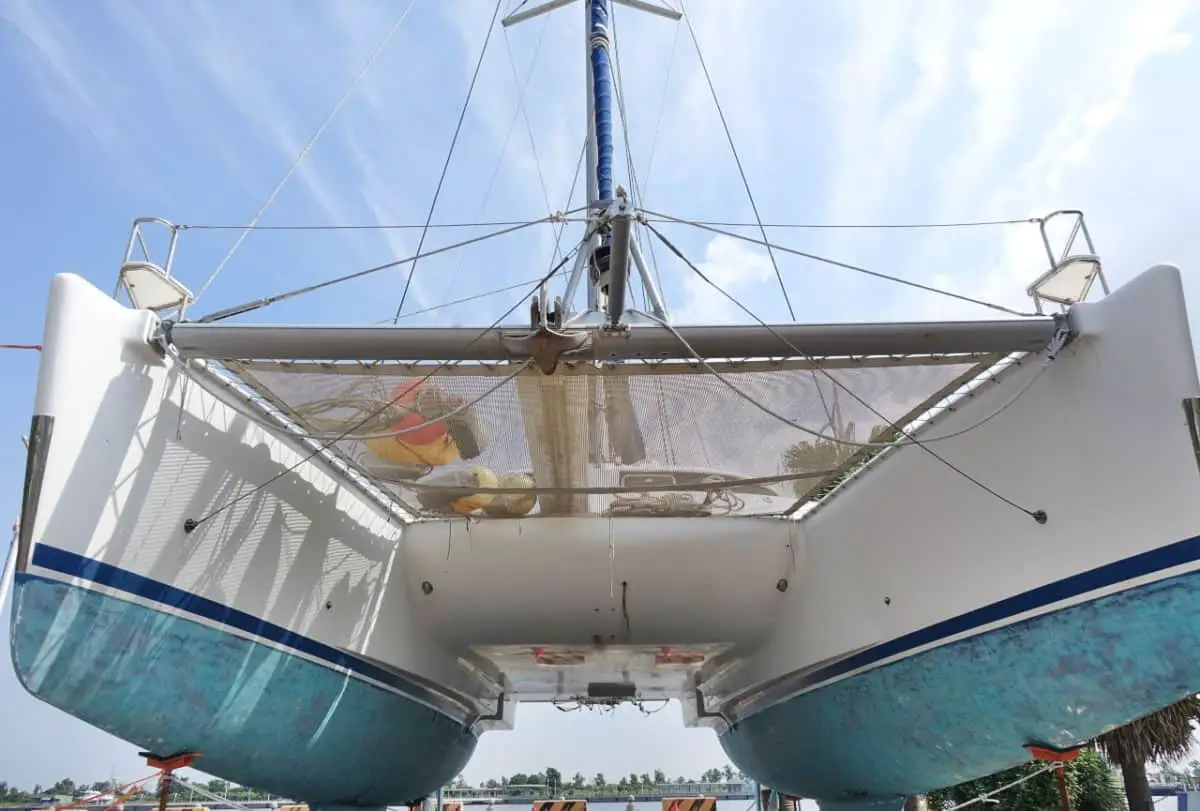
As an Amazon Associate, we earn from qualifying purchases. We may also earn commissions if you purchase products from other retailers after clicking on a link from our site.
Whether you’re a sailing enthusiast or have recently adopted an interest in yachts, you’ve probably heard of catamarans. It can be confusing as the term seems to describe boats, ships, and even massive-cruise vessels. So, what is a catamaran?
A catamaran is a boat with two hulls and a bridge between them. Catamarans can be designed as sailboats or motorboats. A catamaran stays stable since it has a wide base, it does not have a deep keel as on a monohull . Cats are known for not heeling, increased comfort, more space, and faster speeds.
In this article, we will explore everything you need to know about this design, including its origin and its advantages.
Table of Contents
Catamaran: A Basic Overview
The term catamaran comes from a 17th-century Tamil term kaṭṭumaram . The Tamil word stands for “tied wood,” but those vessels do not share the same working principle as catamarans.
Even though most “tied wood” rafts in the 17th century India used two logs to keep the deck afloat, the logs acted more like pontoons than catamaran hulls. However, the commonality of two logs translated to catamarans, as these vessels generally have two hulls.

Since the term refers to the design, it is correct to refer to any vessel with two hulls connected by a bridge as a catamaran. However, technical accuracy doesn’t necessarily mean general-use correctness. While cruise ships can have catamaran design and small rafts may feature two hulls, the term is most often used for yacht-sized cruising sailboats.
Buyers who would not previously afford any vessel close to a mid-sized yacht can easily order a brand-new catamaran. Even investors interested in collecting income from catamaran renting opt for medium scale catamarans to hedge against depreciation and damage. Therefore, the term catamaran has become synonymous with medium-scale yachts with two hulls.
For the rest of this article, we’ll use the term to reflect these vessels, and if a catamaran-style cruise-ship or smaller boats are brought up, the distinction will be highlighted. It is also worth noting that even when dealing with manufacturers and industry literature, the word will refer to medium-sized yachts unless specifically differentiated.
What Are Catamarans Made Of?
One of the most interesting subjects in the overall catamaran conversation is the materials used to manufacture these vessels. That’s because different brands use different technology to compose the materials required for the hulls and other areas of a catamaran.
Hulls of a Bali catamaran are built with sandwich infusion technology using polyester and closed-cell PVC. The brand’s catamarans are fitted with daggerboards, and material variety includes Kevlar in regions of impact and carbon fiber in the lower-weight areas.

Lagoon catamarans have a history of using solid glass below water level , but newer models have a balsa core in the submerged region . While the specifics of composting technology and materials may vary from brand to brand or even model to model within the same brand, the fact that most of these vessels are made of composite material remains consistent.
Parts of a Catamaran
One cannot ask what a catamaran is without getting curious about the various parts of such a vessel. Here is a breakdown of the various parts that go into this vell’s construction:
Unlike monohulls, a catamaran has two of these. They’re usually hollow and fitted out with beds and even a glass window to look out into the water since they’re not submerged. The hulls’ function is to push down on the water, so the water reacts by pushing the vessel up. Therefore, they play an essential role in the catamaran’s buoyancy.
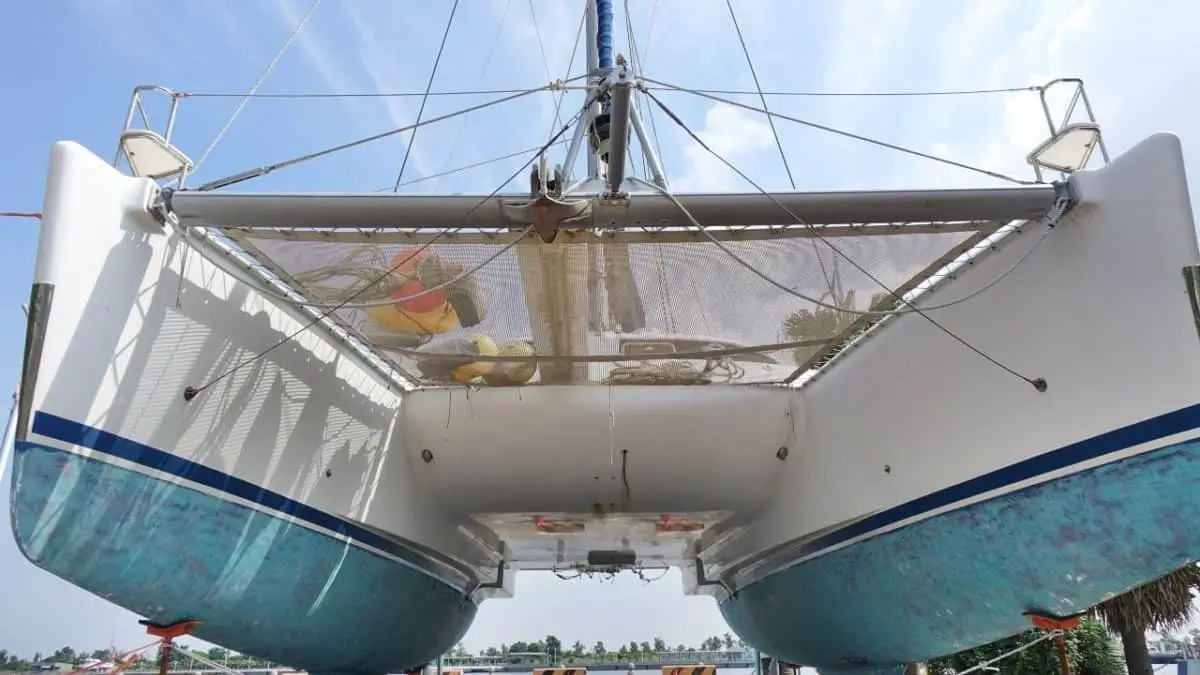
Cross Beams
Because the hulls exert force on the water, there needs to be something that ensures the water’s reaction (upwards force) doesn’t break the deck. Crossbeams serve as connectors between the two hulls and hold them together such that water’s upward force is distributed evenly across the surface between the hulls.
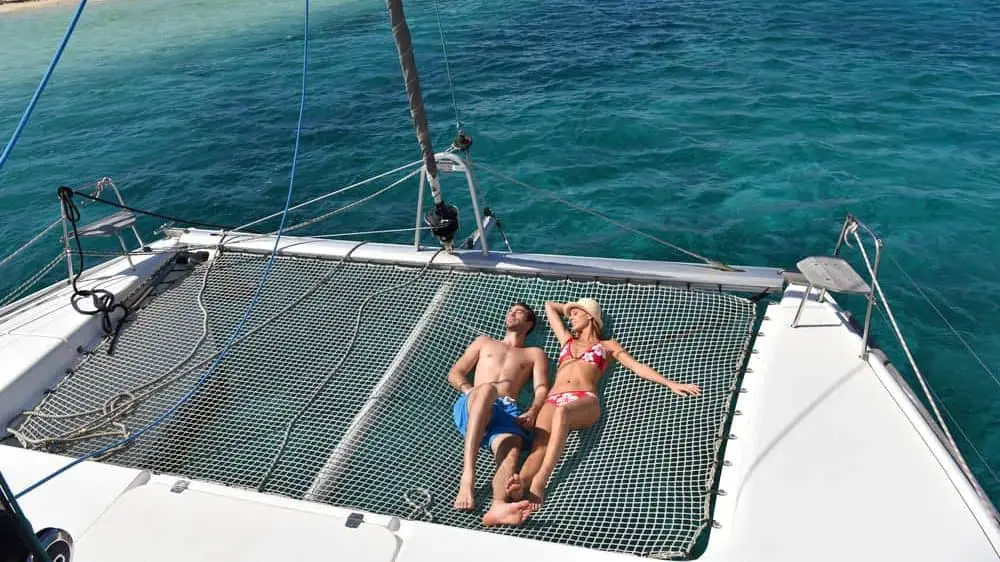
Depending on the size of the vessel, the number of cross beams may vary. Some of the critical characteristics of cross beams include high density and low surface area.
A bridgedeck, as the name suggests, is a deck that serves as a bridge between the hulls. Manufacturers make a compromise between space and sailing efficiency when deciding how to design a bridgedeck for their catamarans. A bridgedeck is given significant clearance to allow for smooth sailing but not too much to leave behind, only the deck for living space.
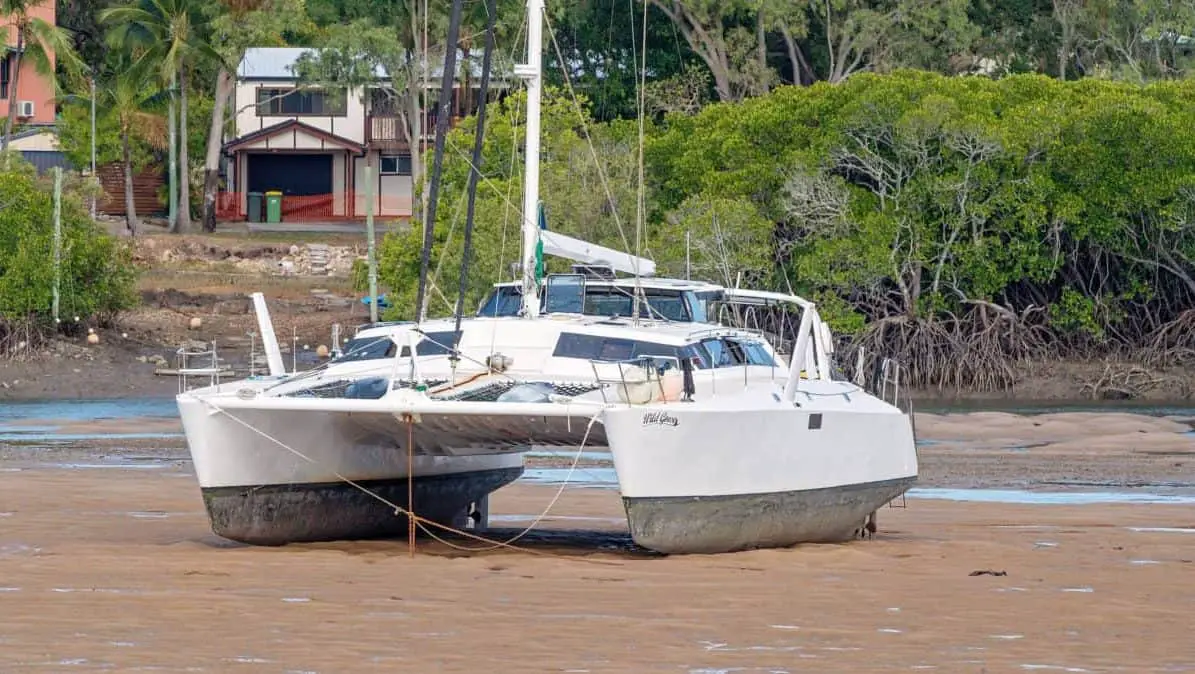
What you should keep in mind about a bridgedeck is that the smaller its clearance, the more water hits its bottom, causing discomfort for those sailing and dealing damage to the vessel. Also, you can’t minimize the bridgedeck without affecting the hull size, which means you have to compromise between the two.
Bridge deck slamming explained
Other Parts
While the aforementioned parts are key to a catamaran’s construction, they are by no means an exhaustive list of every vessel’s component.
Catamarans have a topdeck, oftentimes a saloon, and separate chambers depending on the size. The standard vessel will have the interior fitting of a yacht of a similar size. Since none of these parts are specific to catamarans, a detailed breakdown of each isn’t necessary.
Catamaran parts explained
How Long Does a Catamaran Last?
Since catamarans aren’t impulse-buys, you must consider the longevity of the specific model you wish to buy. If you go with a boutique manufacturer without knowing about materials and construction, you may be sold a vessel that may last only seven years.
On the other hand, brands that list their construction methods with transparency regarding materials used are more confident in their product, which has five times the longevity of a cheaply manufactured catamaran.
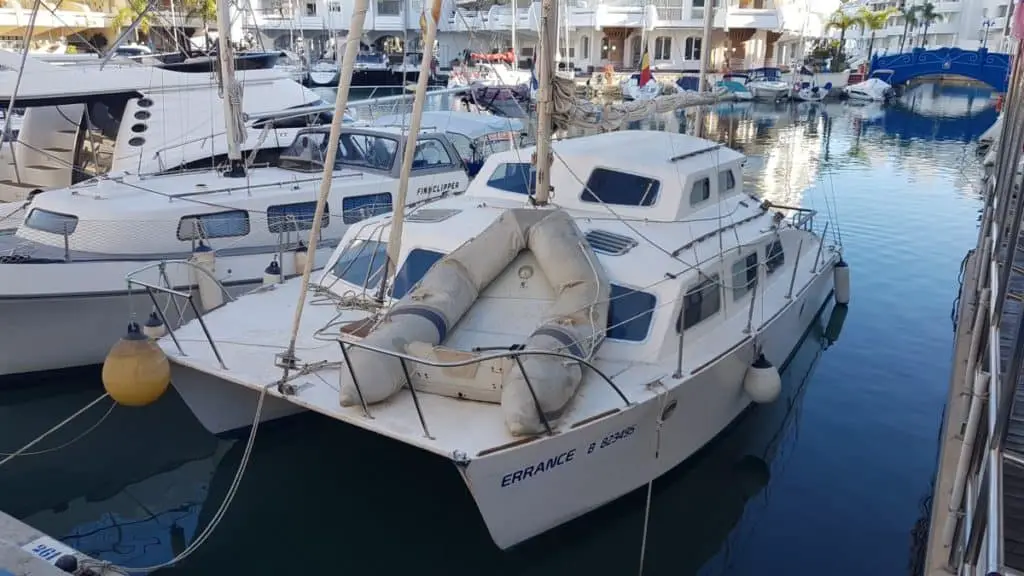
Suppose you wish to purchase a catamaran you want to have for 15+ years. In that case, you may avoid buying a “performance” catamaran that focuses on lightweight in favor of sailing speed and effortlessness on the waves. This conversation becomes more complicated when you consider sailing frequency and its impact on different vessels.
Generally speaking, expecting your catamaran to remain functional and smooth sailing for fifteen years is reasonable. That doesn’t mean any catamaran you purchase will fit this criterion but only suggests that you will find vessels with this longevity with relative ease.
Is It Easier to Sail a Catamaran?
It is essential to address different sizes of catamarans when this question arises. Sailing a catamaran sailboat is different from captaining a standard (yacht-sized) catamaran. Since yacht-sized catamarans can come with an autopilot, as can their monohull equivalents, the question becomes more about the sailing experience.
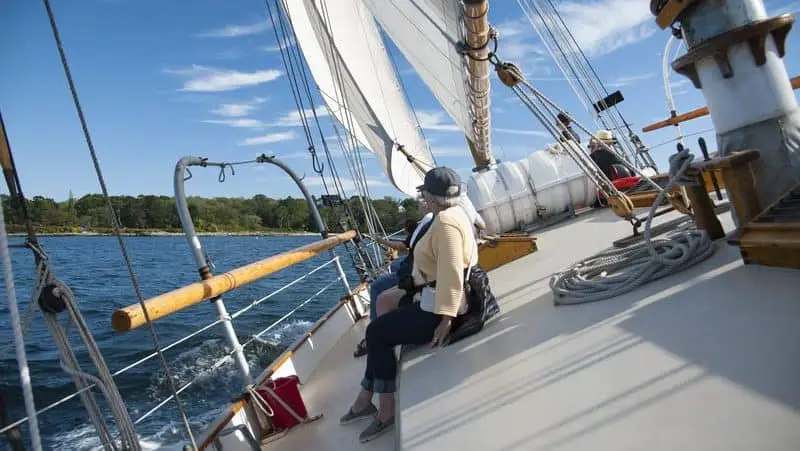
Your guests are more comfortable in a catamaran as the sailing experience doesn’t translate water resistance and wind to the vessel’s interior as much as it does in a monohull. Monohulls get hit by waves that pass between the two hulls of a catamaran.
As for physically sailing a catamaran-design vessel, the experience is different but not objectively easier. For instance, if you’re a seasoned monohull sailor, you’ll find what you’re used to much easier than adjusting two catamarans.
Final Thoughts
Catamarans are self-balancing and easy to learn, making them a preferred sailing choice among novices and time-strapped sailing enthusiasts. They have recently become symbols of luxury with comfortable interiors and ample living space.
Owner of CatamaranFreedom.com. A minimalist that has lived in a caravan in Sweden, 35ft Monohull in the Bahamas, and right now in his self-built Van. He just started the next adventure, to circumnavigate the world on a Catamaran!
Leave a Reply Cancel reply
Your email address will not be published. Required fields are marked *
Save my name and email in this browser for the next time I comment.
Recent Posts
Must-Have Boat Gear for Catamaran Sailors!
Sailing is probably the most gear-intensive activity I've ever done; there are so many decisions to be made about what gear to buy now, for tomorrow, and what to definitely never buy. The gear on...
6 Best Trailerable Trimarans For Bluewater and Coastal Sailing
Having a boat costs a lot of money, even when you are not using it, marina fees, etc. And once it is in the water most sailors never go very far from their "home marina" and sailing will be somewhat...

- Join Newsletter
Our Promise to you
Founded in 2002, our company has been a trusted resource for readers seeking informative and engaging content. Our dedication to quality remains unwavering—and will never change. We follow a strict editorial policy , ensuring that our content is authored by highly qualified professionals and edited by subject matter experts. This guarantees that everything we publish is objective, accurate, and trustworthy.
Over the years, we've refined our approach to cover a wide range of topics, providing readers with reliable and practical advice to enhance their knowledge and skills. That's why millions of readers turn to us each year. Join us in celebrating the joy of learning, guided by standards you can trust.
What are Catamarans?
Catamarans, often called 'cats' in boating circles, are twin-hulled watercraft noted for their speed and stability in open water. Many long-distance sailing races are won by these boats, although traditional boat designers haven't always embraced their unorthodox features. This type of boat can be powered by sails placed forward or by engines mounted in the central rear.
The first catamarans were designed and sailed by affluent fishing tribes working in the Indonesian area of the Indian ocean. The name is an anglicized pronunciation of the Tamil word kattumaram , literally translated as logs tied together. Instead of using the traditional single-hulled design of a canoe, the first versions of this boat used two separate pontoons held apart by a single deck and diagonal strapping, with a sail mounted on the forward section of the deck. Eventually, their speed and maneuverability proved useful in the defense of Indonesian trade routes.
These boats are still considered to be among the fastest sailing boats available. Typically, catamarans use deep V-shaped hulls to cut through the water, creating a phenomenon known as planing. When running at full speed, boats of this design may only have a few inches of the hulls remaining in the water. Because their hulls are generally thinner than those of monohull boats, they're are also noticeably lighter. The stability of two hulls and a central deck eliminates the need for additional ballast.
This is not to say that catamarans are easier to sail than other sailboat designs. Pilots often have to lean out of the opposite hull in order to counterbalance the boat during a turn. They have a tendency to capsize if the sails are not reversed in time. Pilots cannot always follow a straight course while steering them — a series of zig-zags may be required.
Powered catamarans can be very large indeed, with some top-end models rivaling yachts and small cruise ships. Military ship designers are also creating fortified versions for use as swift-moving transporters. Small sail-powered types can be purchased for a few thousand US dollars, while luxury models may run into the hundreds of thousands of dollars. Special trailers may be required to transport catamarans over standard roadways, since the boat must be tilted to meet load width regulations. Storage slips on the water may also be difficult to obtain because of the boat's wider dimensions.
Editors' Picks

Related Articles
- What Does "Capsize" Mean?
- What Is the Difference between a Catamaran and a Yacht?
- What Are Multihull Boats?
- How Do I Choose the Best Yacht Trailer?
- What Is a Power Catamaran?
- How Do I Choose the Best Personal Watercraft Trailer?
- What Is a Log Canoe?

Our latest articles, guides, and more, delivered daily.
- European Union
- South Africa
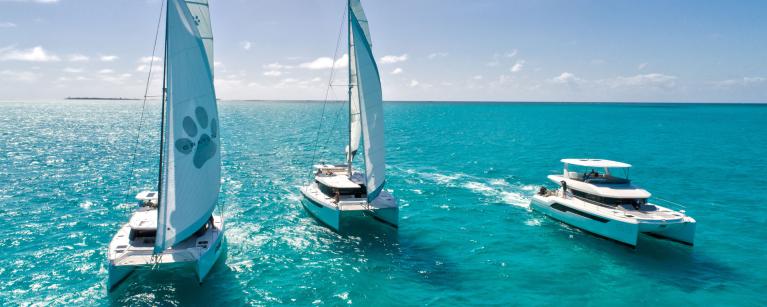
The Leopard Identity
Leopard Catamarans pushes the boundaries of catamaran design.
Evolving from 50 years of customer feedback, Leopard Catamarans has pooled their expertise with builders Robertson and Caine to design today's Leopard range: spacious, robust, performance-driven blue water cruising catamarans. As the worldwide distributor, we’re proud to say that over 2,500 Leopard cats have now been delivered all over the globe.
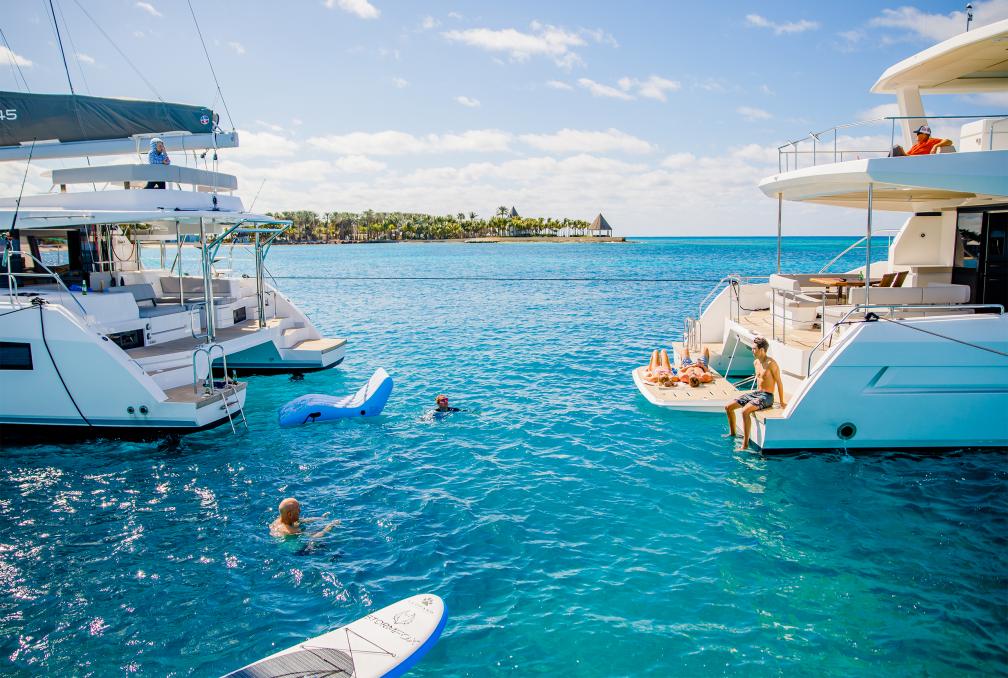
Pricing & Options
Latest news.

Sailing a New Leopard Home: Leopard 50 Atlantic Crossing


COMMENTS
Powered catamaran passenger ferry at Salem, Massachusetts, United States. A catamaran ( / ˌkætəməˈræn /) (informally, a "cat") is a watercraft with two parallel hulls of equal size. The distance between a catamaran's hulls imparts resistance to rolling and overturning. Catamarans typically have less hull volume, smaller displacement, and ...
The official organisation for the A-Class catamaran is the IACA (International A division Catamarans Association). The A-Class rules were expanded over time to prevent the cost of these boats from rising too high and to ensure fairness in racing. Currently the main A-Class rules are: [3] Min overall boat weight : 75 kg / 165.3 lbs.
James Wharram (15 May 1928 - 14 December 2021) was a British multihull pioneer and designer of catamarans .
Catamarans: A Complete Guide to Multihull Boats Catamarans have been a part of sailing history for centuries and continue to be popular for their stability, spaciousness, and performance. Developed by various cultures around the world, the principles of catamaran design have evolved over time to become optimized for both pleasure cruising and racing. This complete guide will help you ...
A catamaran is a design for a boat that utilizes two hulls. Due to the flat, platform-like-potential for the deck of the boat, the catamaran is often purposed with transporting materials, vehicles, and people. For instance, catamarans are quite often used as ferries.
catamaran, twin-hulled sailing and powered boat developed for sport and recreation in the second half of the 20th century. Its design is based on a raft of two logs bridged by planks that had earlier been used by peoples in the Indonesian archipelago and throughout Polynesia and Micronesia. Early catamarans were up to 21.3 metres (70 feet) long ...
catamaran (plural catamarans) A twin - hulled ship or boat . Swift over the seas the vessel drives; Madras appears in sight. The first object catching the eye, upon the anchor being cast, was an Indian upon his catamaran, who, making a sudden motion, sprung to the side of the ship, grappled there for a moment, and the next was on the deck ...
A catamaran is a watercraft with two parallel hulls of equal size. The distance between a catamaran's hulls imparts resistance to rolling and overturning. Catamarans typically have less hull volume, smaller displacement, and shallower draft (draught) than monohulls of comparable length. The two hulls combined also often have a smaller hydrodynamic resistance than comparable monohulls ...
Catamaran - New World Encyclopedia. A catamaran. Fishermen with their catamarans in Chennai. A catamaran (from Tamil kattumaram) [1] is a type of multihulled boat or ship consisting of two hulls, or Vakas, joined by a frame, formed of Akas. Catamarans can be sail- or engine-powered. The catamaran was first discovered being used by the paravas ...
What Is A Catamaran? A catamaran is a type of boat with two hulls connected by beams. It is usually powered by sails, although all modern catamarans come with inboard motors for propulsion. Catamarans are traditionally used for sailing, fishing, and leisure activities. They can be used in both fresh and salt water, and their light weight allows them to travel at high speeds without using much ...
What are the different types of catamarans? Catamarans are mainly divided into two categories: sailing and power catamarans, however, both categories can be split into smaller groups by their size and use.
Un catamaran traditionnel sur le lac Pulicat, Inde du Sud. Le pirate et aventurier anglais William Dampier, alors qu'il parcourait le monde dans les années 1690, fut le premier Européen à décrire un catamaran alors qu'il naviguait dans le golfe du Bengale, dans la région du Tamil Nadu.Il les décrit, en 1697, de la façon suivante : « Sur la côte de Coromandel, on les appelle catamarans.
SL 16. Small-waterplane-area twin hull. Sol Cat 18. Spitfire (catamaran) Sprint 15. Stingray catamaran. Sydney JetCats. Sydney RiverCat. Sydney SuperCats.
A catamaran (/ˌkætəməˈræn/) (informally, a cat) is a watercraft with two parallel hulls of equal size. The distance between a catamaran's hulls imparts resistance to rolling and overturning. Catamarans typically have less hull volume, smaller displacement, and shallower draft (draught) than monohull
The twin hulls of a catamaran serve a number of purposes. Weight is reduced by using two smaller, shallower hulls rather than a single, deep hull. The long, slender shape of the catamaran hull minimizes wetted surface area. And the hull shape minimizes cross-sectional area. Depending on the point of sail, the benefits of dual hulls are realized by balancing the boat on one of the two hulls, or ...
The Beginner's Guide to Sailing Catamarans. When it comes to sailing, having access to the most innovative, top quality yachts does make a difference. This is how a vacation on the water goes from ordinary to extraordinary. The Moorings catamarans are exclusively designed by renowned boat builders Robertson & Caine, a South African company ...
A catamaran is a boat with two hulls and a bridge between them. Catamarans can be designed as sailboats or motorboats. A catamaran stays stable since it has a wide base, it does not have a deep keel as on a monohull. Cats are known for not heeling, increased comfort, more space, and faster speeds. In this article, we will explore everything you ...
Catamarans, often called 'cats' in boating circles, are twin-hulled watercraft noted for their speed and stability in open water. Many long-distance sailing races are won by these boats, although traditional boat designers haven't always embraced their unorthodox features. This type of boat can be powered by sails placed forward or by engines mounted in the central rear.
Kattumaram (கட்டுமரம்) is a traditional Tamil watercraft used in the Coast of Southern India, Sri Lanka, and Bangladesh. They are characterized by being made from three to seven tree trunks tied together with fiber lashings and/or treenails. [1] The lashings are not permanent and the individual tree trunks are commonly separated to dry under the sun when kattumaram are ...
The Leopard Identity. Leopard Catamarans pushes the boundaries of catamaran design. Evolving from 50 years of customer feedback, Leopard Catamarans has pooled their expertise with builders Robertson and Caine to design today's Leopard range: spacious, robust, performance-driven blue water cruising catamarans. As the worldwide distributor, we ...
Lagoon catamaran is a brand of twin-hulled boats that are designed and produced in Bordeaux, France. The company began in 1984 as a specialist multihull division of Jeanneau, a volume monohull constructor.
The Gunboat team, from its shipyard in La Grande Motte (France), build high-performance and elegant yachts made for cruising and regattas.
Hobie Cat. Hobie Cat is a company that manufactures watercraft and other products as the Hobie Cat Company. "Hobie Cat" can also refer to specific products of the company, notably its sailing catamarans. Its fiberglass catamaran models range in nominal length between 14 feet (4.3 m) and 18 feet (5.5 m).